Business Issues - Assignment Sample
VerifiedAdded on 2021/05/30
|23
|7219
|47
AI Summary
Contribute Materials
Your contribution can guide someone’s learning journey. Share your
documents today.
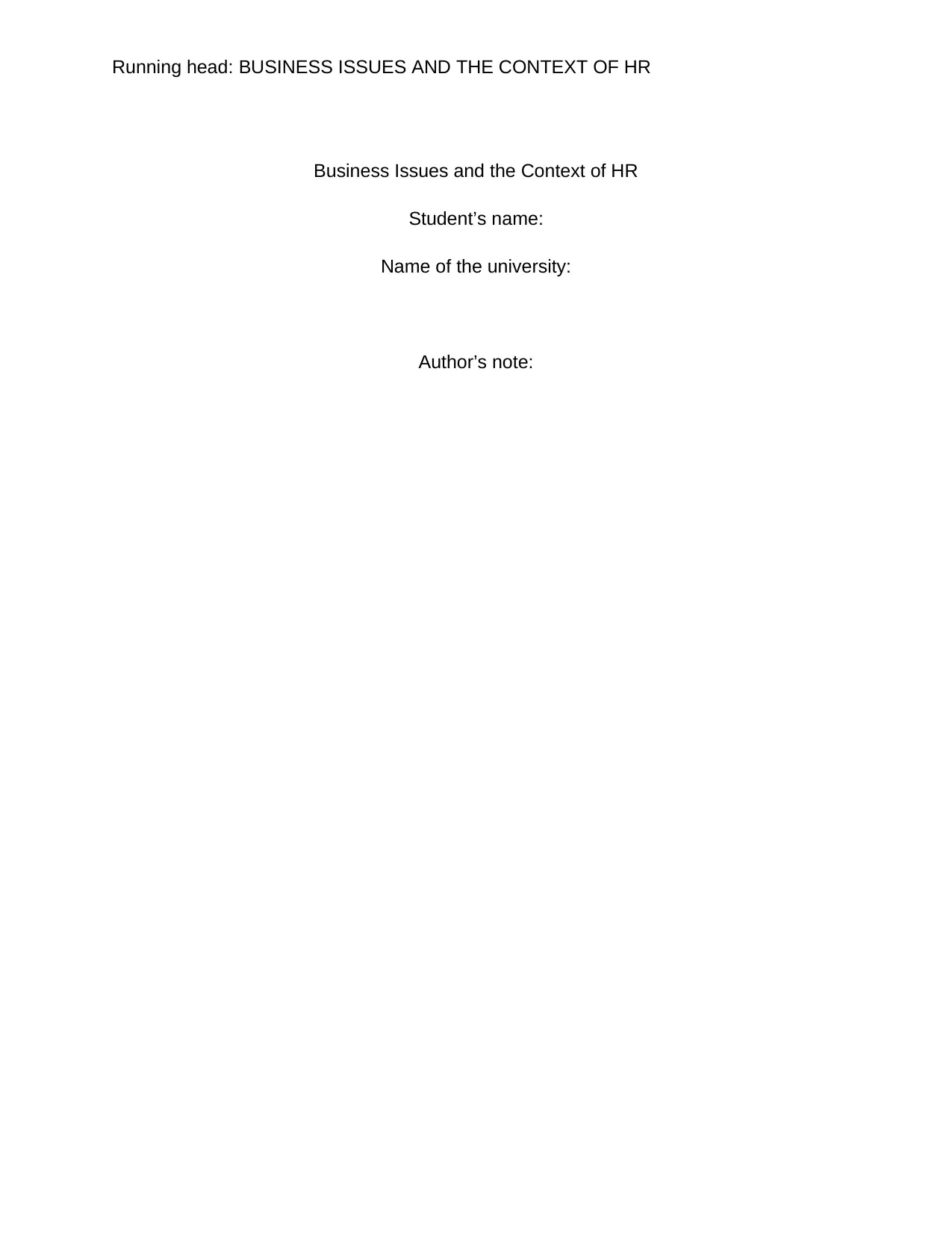
Running head: BUSINESS ISSUES AND THE CONTEXT OF HR
Business Issues and the Context of HR
Student’s name:
Name of the university:
Author’s note:
Business Issues and the Context of HR
Student’s name:
Name of the university:
Author’s note:
Secure Best Marks with AI Grader
Need help grading? Try our AI Grader for instant feedback on your assignments.
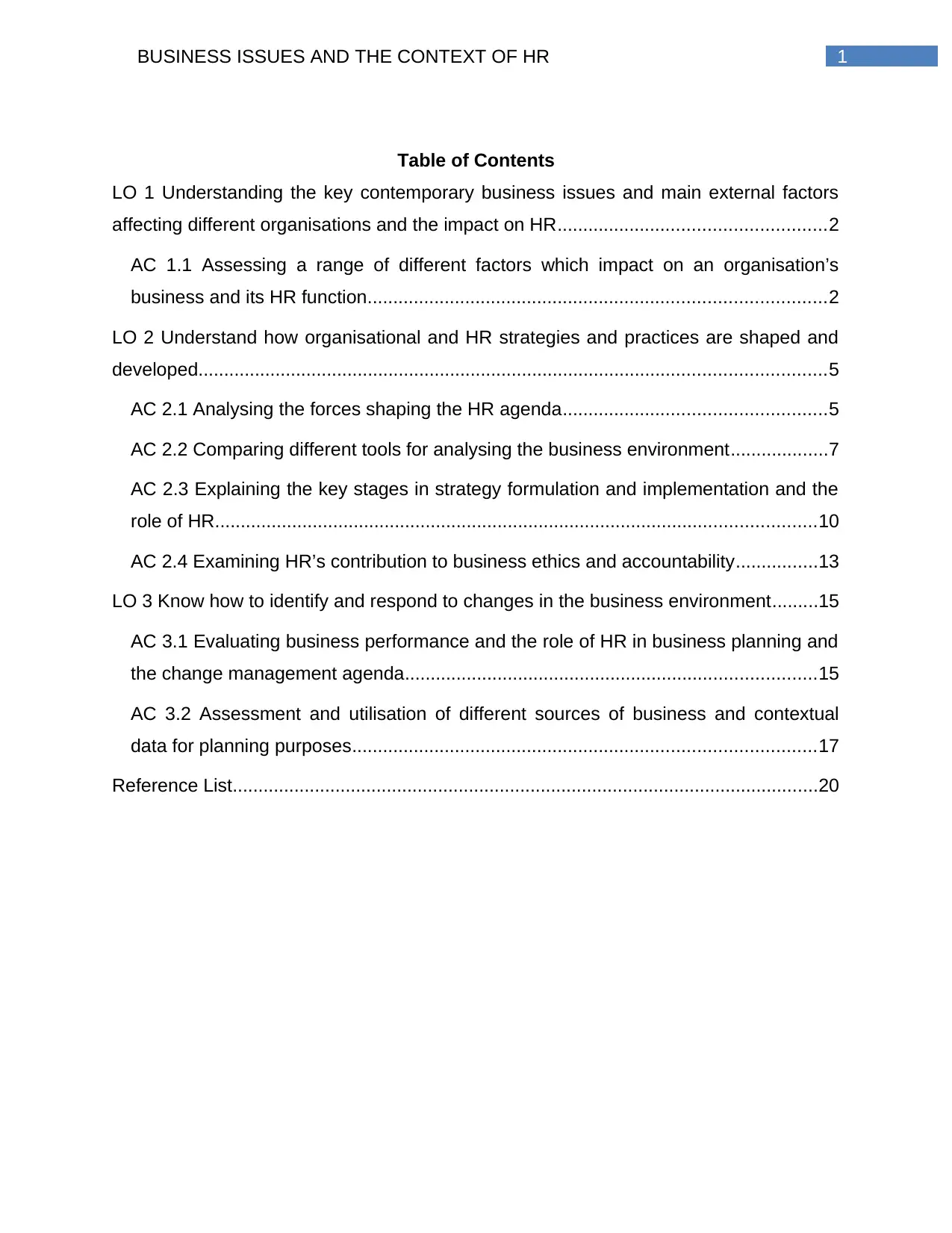
1BUSINESS ISSUES AND THE CONTEXT OF HR
Table of Contents
LO 1 Understanding the key contemporary business issues and main external factors
affecting different organisations and the impact on HR....................................................2
AC 1.1 Assessing a range of different factors which impact on an organisation’s
business and its HR function.........................................................................................2
LO 2 Understand how organisational and HR strategies and practices are shaped and
developed..........................................................................................................................5
AC 2.1 Analysing the forces shaping the HR agenda...................................................5
AC 2.2 Comparing different tools for analysing the business environment...................7
AC 2.3 Explaining the key stages in strategy formulation and implementation and the
role of HR.....................................................................................................................10
AC 2.4 Examining HR’s contribution to business ethics and accountability................13
LO 3 Know how to identify and respond to changes in the business environment.........15
AC 3.1 Evaluating business performance and the role of HR in business planning and
the change management agenda................................................................................15
AC 3.2 Assessment and utilisation of different sources of business and contextual
data for planning purposes..........................................................................................17
Reference List..................................................................................................................20
Table of Contents
LO 1 Understanding the key contemporary business issues and main external factors
affecting different organisations and the impact on HR....................................................2
AC 1.1 Assessing a range of different factors which impact on an organisation’s
business and its HR function.........................................................................................2
LO 2 Understand how organisational and HR strategies and practices are shaped and
developed..........................................................................................................................5
AC 2.1 Analysing the forces shaping the HR agenda...................................................5
AC 2.2 Comparing different tools for analysing the business environment...................7
AC 2.3 Explaining the key stages in strategy formulation and implementation and the
role of HR.....................................................................................................................10
AC 2.4 Examining HR’s contribution to business ethics and accountability................13
LO 3 Know how to identify and respond to changes in the business environment.........15
AC 3.1 Evaluating business performance and the role of HR in business planning and
the change management agenda................................................................................15
AC 3.2 Assessment and utilisation of different sources of business and contextual
data for planning purposes..........................................................................................17
Reference List..................................................................................................................20
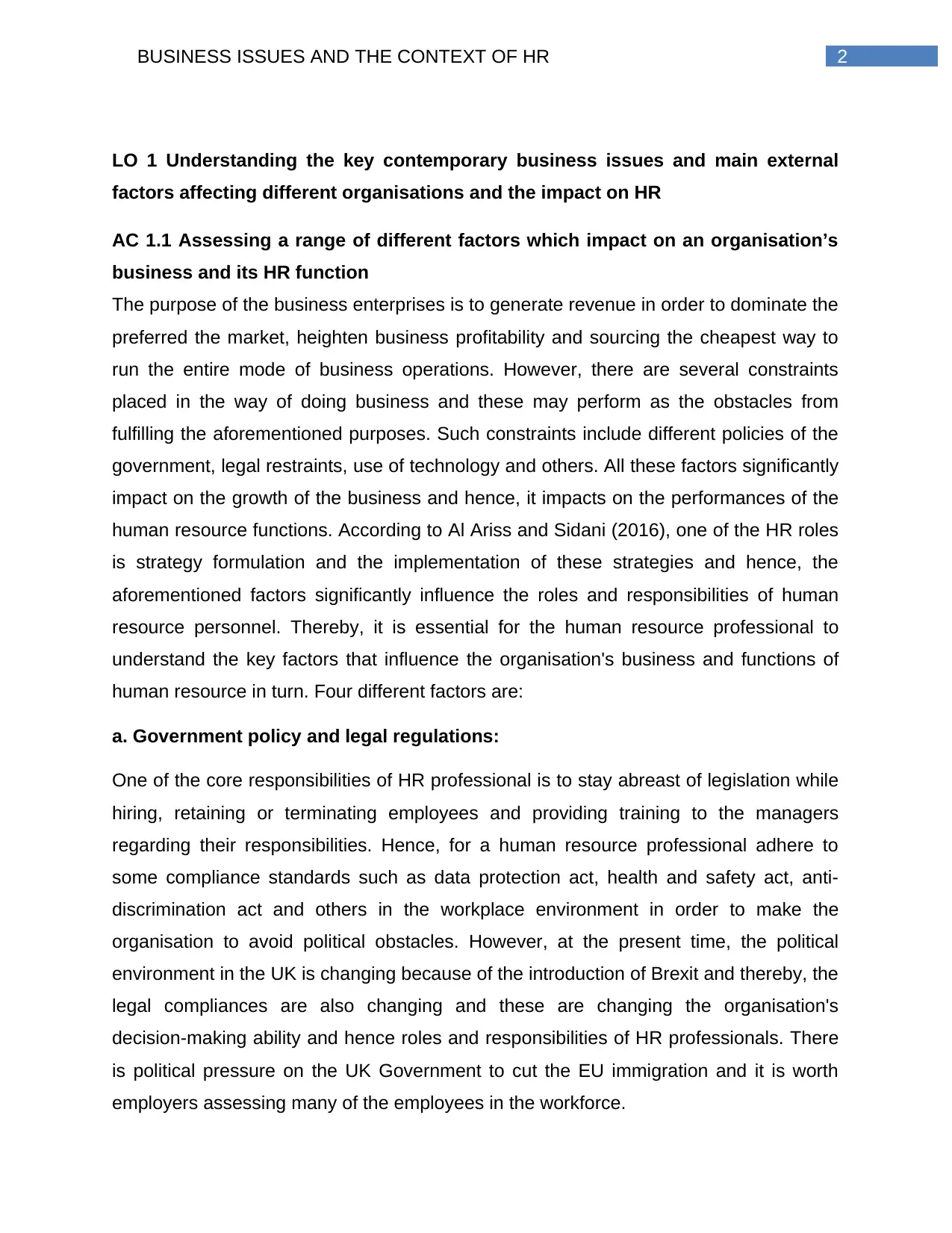
2BUSINESS ISSUES AND THE CONTEXT OF HR
LO 1 Understanding the key contemporary business issues and main external
factors affecting different organisations and the impact on HR
AC 1.1 Assessing a range of different factors which impact on an organisation’s
business and its HR function
The purpose of the business enterprises is to generate revenue in order to dominate the
preferred the market, heighten business profitability and sourcing the cheapest way to
run the entire mode of business operations. However, there are several constraints
placed in the way of doing business and these may perform as the obstacles from
fulfilling the aforementioned purposes. Such constraints include different policies of the
government, legal restraints, use of technology and others. All these factors significantly
impact on the growth of the business and hence, it impacts on the performances of the
human resource functions. According to Al Ariss and Sidani (2016), one of the HR roles
is strategy formulation and the implementation of these strategies and hence, the
aforementioned factors significantly influence the roles and responsibilities of human
resource personnel. Thereby, it is essential for the human resource professional to
understand the key factors that influence the organisation's business and functions of
human resource in turn. Four different factors are:
a. Government policy and legal regulations:
One of the core responsibilities of HR professional is to stay abreast of legislation while
hiring, retaining or terminating employees and providing training to the managers
regarding their responsibilities. Hence, for a human resource professional adhere to
some compliance standards such as data protection act, health and safety act, anti-
discrimination act and others in the workplace environment in order to make the
organisation to avoid political obstacles. However, at the present time, the political
environment in the UK is changing because of the introduction of Brexit and thereby, the
legal compliances are also changing and these are changing the organisation's
decision-making ability and hence roles and responsibilities of HR professionals. There
is political pressure on the UK Government to cut the EU immigration and it is worth
employers assessing many of the employees in the workforce.
LO 1 Understanding the key contemporary business issues and main external
factors affecting different organisations and the impact on HR
AC 1.1 Assessing a range of different factors which impact on an organisation’s
business and its HR function
The purpose of the business enterprises is to generate revenue in order to dominate the
preferred the market, heighten business profitability and sourcing the cheapest way to
run the entire mode of business operations. However, there are several constraints
placed in the way of doing business and these may perform as the obstacles from
fulfilling the aforementioned purposes. Such constraints include different policies of the
government, legal restraints, use of technology and others. All these factors significantly
impact on the growth of the business and hence, it impacts on the performances of the
human resource functions. According to Al Ariss and Sidani (2016), one of the HR roles
is strategy formulation and the implementation of these strategies and hence, the
aforementioned factors significantly influence the roles and responsibilities of human
resource personnel. Thereby, it is essential for the human resource professional to
understand the key factors that influence the organisation's business and functions of
human resource in turn. Four different factors are:
a. Government policy and legal regulations:
One of the core responsibilities of HR professional is to stay abreast of legislation while
hiring, retaining or terminating employees and providing training to the managers
regarding their responsibilities. Hence, for a human resource professional adhere to
some compliance standards such as data protection act, health and safety act, anti-
discrimination act and others in the workplace environment in order to make the
organisation to avoid political obstacles. However, at the present time, the political
environment in the UK is changing because of the introduction of Brexit and thereby, the
legal compliances are also changing and these are changing the organisation's
decision-making ability and hence roles and responsibilities of HR professionals. There
is political pressure on the UK Government to cut the EU immigration and it is worth
employers assessing many of the employees in the workforce.
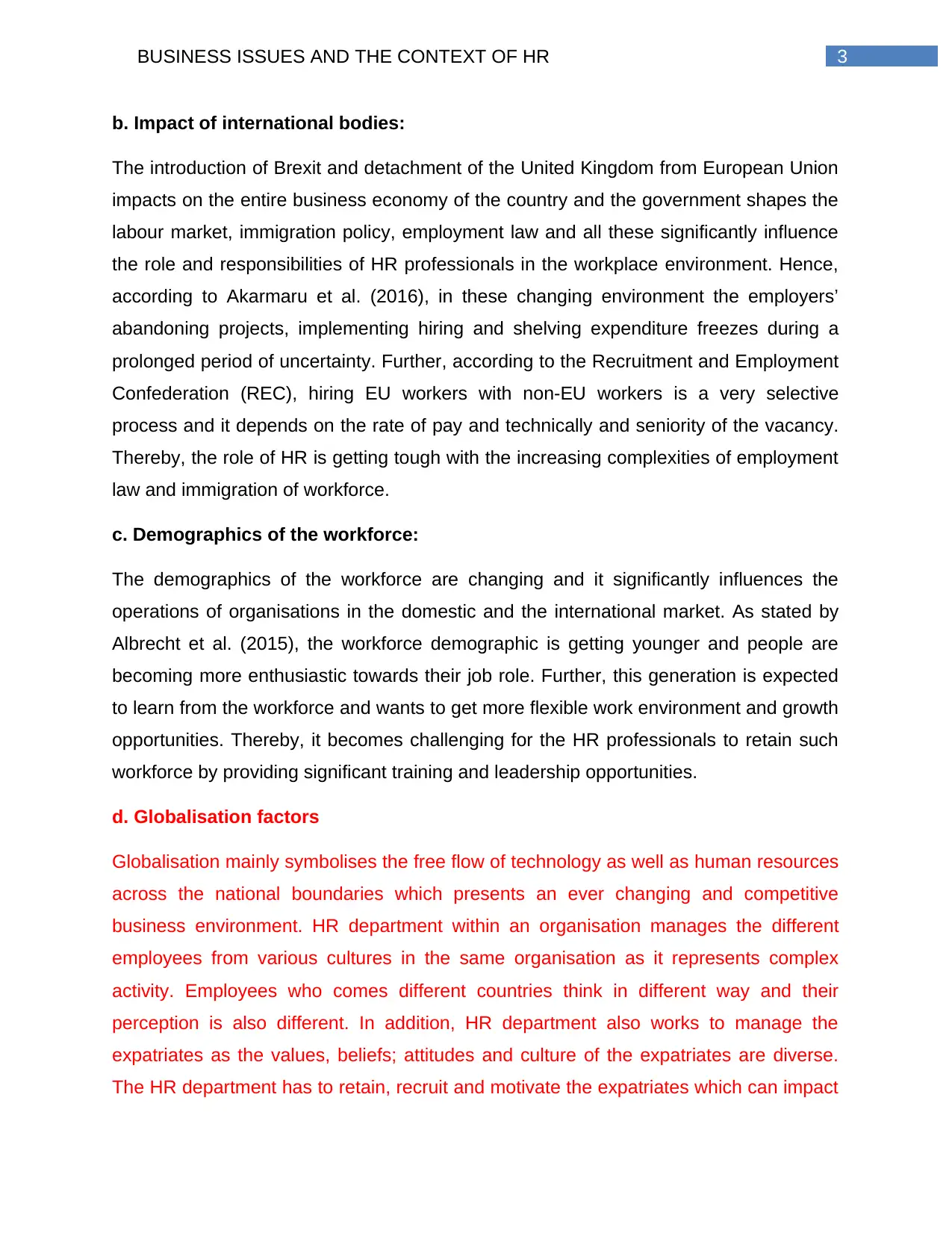
3BUSINESS ISSUES AND THE CONTEXT OF HR
b. Impact of international bodies:
The introduction of Brexit and detachment of the United Kingdom from European Union
impacts on the entire business economy of the country and the government shapes the
labour market, immigration policy, employment law and all these significantly influence
the role and responsibilities of HR professionals in the workplace environment. Hence,
according to Akarmaru et al. (2016), in these changing environment the employers’
abandoning projects, implementing hiring and shelving expenditure freezes during a
prolonged period of uncertainty. Further, according to the Recruitment and Employment
Confederation (REC), hiring EU workers with non-EU workers is a very selective
process and it depends on the rate of pay and technically and seniority of the vacancy.
Thereby, the role of HR is getting tough with the increasing complexities of employment
law and immigration of workforce.
c. Demographics of the workforce:
The demographics of the workforce are changing and it significantly influences the
operations of organisations in the domestic and the international market. As stated by
Albrecht et al. (2015), the workforce demographic is getting younger and people are
becoming more enthusiastic towards their job role. Further, this generation is expected
to learn from the workforce and wants to get more flexible work environment and growth
opportunities. Thereby, it becomes challenging for the HR professionals to retain such
workforce by providing significant training and leadership opportunities.
d. Globalisation factors
Globalisation mainly symbolises the free flow of technology as well as human resources
across the national boundaries which presents an ever changing and competitive
business environment. HR department within an organisation manages the different
employees from various cultures in the same organisation as it represents complex
activity. Employees who comes different countries think in different way and their
perception is also different. In addition, HR department also works to manage the
expatriates as the values, beliefs; attitudes and culture of the expatriates are diverse.
The HR department has to retain, recruit and motivate the expatriates which can impact
b. Impact of international bodies:
The introduction of Brexit and detachment of the United Kingdom from European Union
impacts on the entire business economy of the country and the government shapes the
labour market, immigration policy, employment law and all these significantly influence
the role and responsibilities of HR professionals in the workplace environment. Hence,
according to Akarmaru et al. (2016), in these changing environment the employers’
abandoning projects, implementing hiring and shelving expenditure freezes during a
prolonged period of uncertainty. Further, according to the Recruitment and Employment
Confederation (REC), hiring EU workers with non-EU workers is a very selective
process and it depends on the rate of pay and technically and seniority of the vacancy.
Thereby, the role of HR is getting tough with the increasing complexities of employment
law and immigration of workforce.
c. Demographics of the workforce:
The demographics of the workforce are changing and it significantly influences the
operations of organisations in the domestic and the international market. As stated by
Albrecht et al. (2015), the workforce demographic is getting younger and people are
becoming more enthusiastic towards their job role. Further, this generation is expected
to learn from the workforce and wants to get more flexible work environment and growth
opportunities. Thereby, it becomes challenging for the HR professionals to retain such
workforce by providing significant training and leadership opportunities.
d. Globalisation factors
Globalisation mainly symbolises the free flow of technology as well as human resources
across the national boundaries which presents an ever changing and competitive
business environment. HR department within an organisation manages the different
employees from various cultures in the same organisation as it represents complex
activity. Employees who comes different countries think in different way and their
perception is also different. In addition, HR department also works to manage the
expatriates as the values, beliefs; attitudes and culture of the expatriates are diverse.
The HR department has to retain, recruit and motivate the expatriates which can impact
Secure Best Marks with AI Grader
Need help grading? Try our AI Grader for instant feedback on your assignments.
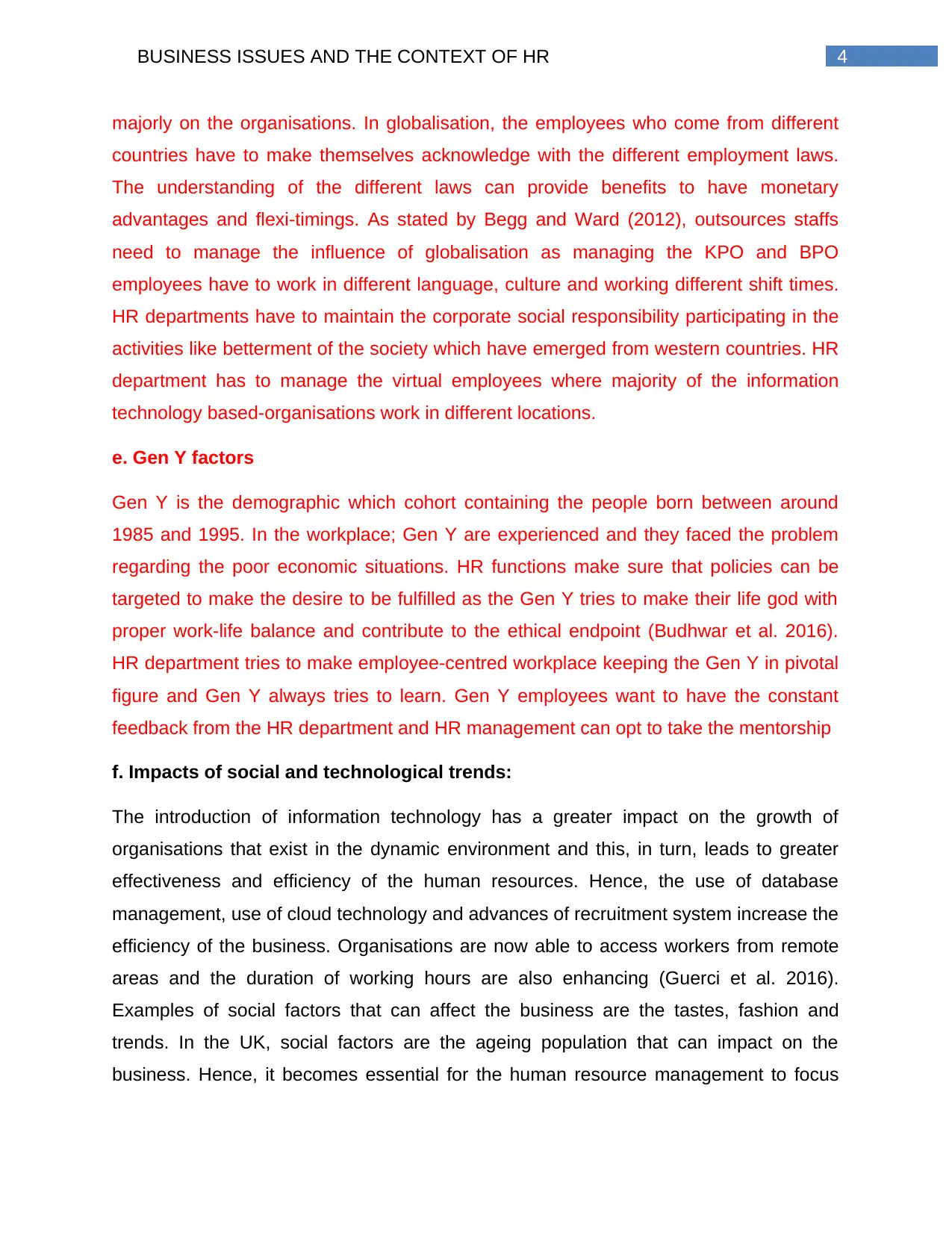
4BUSINESS ISSUES AND THE CONTEXT OF HR
majorly on the organisations. In globalisation, the employees who come from different
countries have to make themselves acknowledge with the different employment laws.
The understanding of the different laws can provide benefits to have monetary
advantages and flexi-timings. As stated by Begg and Ward (2012), outsources staffs
need to manage the influence of globalisation as managing the KPO and BPO
employees have to work in different language, culture and working different shift times.
HR departments have to maintain the corporate social responsibility participating in the
activities like betterment of the society which have emerged from western countries. HR
department has to manage the virtual employees where majority of the information
technology based-organisations work in different locations.
e. Gen Y factors
Gen Y is the demographic which cohort containing the people born between around
1985 and 1995. In the workplace; Gen Y are experienced and they faced the problem
regarding the poor economic situations. HR functions make sure that policies can be
targeted to make the desire to be fulfilled as the Gen Y tries to make their life god with
proper work-life balance and contribute to the ethical endpoint (Budhwar et al. 2016).
HR department tries to make employee-centred workplace keeping the Gen Y in pivotal
figure and Gen Y always tries to learn. Gen Y employees want to have the constant
feedback from the HR department and HR management can opt to take the mentorship
f. Impacts of social and technological trends:
The introduction of information technology has a greater impact on the growth of
organisations that exist in the dynamic environment and this, in turn, leads to greater
effectiveness and efficiency of the human resources. Hence, the use of database
management, use of cloud technology and advances of recruitment system increase the
efficiency of the business. Organisations are now able to access workers from remote
areas and the duration of working hours are also enhancing (Guerci et al. 2016).
Examples of social factors that can affect the business are the tastes, fashion and
trends. In the UK, social factors are the ageing population that can impact on the
business. Hence, it becomes essential for the human resource management to focus
majorly on the organisations. In globalisation, the employees who come from different
countries have to make themselves acknowledge with the different employment laws.
The understanding of the different laws can provide benefits to have monetary
advantages and flexi-timings. As stated by Begg and Ward (2012), outsources staffs
need to manage the influence of globalisation as managing the KPO and BPO
employees have to work in different language, culture and working different shift times.
HR departments have to maintain the corporate social responsibility participating in the
activities like betterment of the society which have emerged from western countries. HR
department has to manage the virtual employees where majority of the information
technology based-organisations work in different locations.
e. Gen Y factors
Gen Y is the demographic which cohort containing the people born between around
1985 and 1995. In the workplace; Gen Y are experienced and they faced the problem
regarding the poor economic situations. HR functions make sure that policies can be
targeted to make the desire to be fulfilled as the Gen Y tries to make their life god with
proper work-life balance and contribute to the ethical endpoint (Budhwar et al. 2016).
HR department tries to make employee-centred workplace keeping the Gen Y in pivotal
figure and Gen Y always tries to learn. Gen Y employees want to have the constant
feedback from the HR department and HR management can opt to take the mentorship
f. Impacts of social and technological trends:
The introduction of information technology has a greater impact on the growth of
organisations that exist in the dynamic environment and this, in turn, leads to greater
effectiveness and efficiency of the human resources. Hence, the use of database
management, use of cloud technology and advances of recruitment system increase the
efficiency of the business. Organisations are now able to access workers from remote
areas and the duration of working hours are also enhancing (Guerci et al. 2016).
Examples of social factors that can affect the business are the tastes, fashion and
trends. In the UK, social factors are the ageing population that can impact on the
business. Hence, it becomes essential for the human resource management to focus
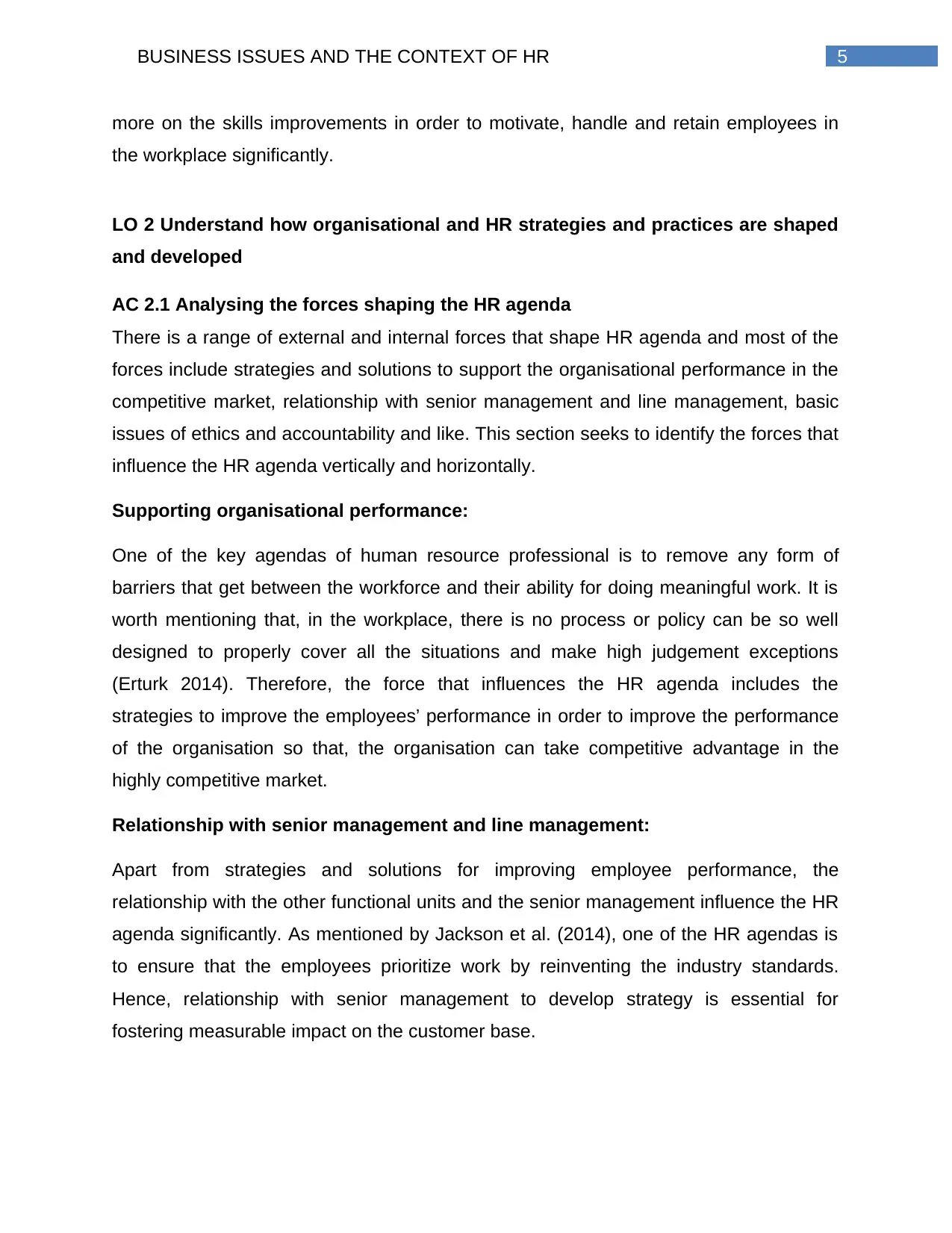
5BUSINESS ISSUES AND THE CONTEXT OF HR
more on the skills improvements in order to motivate, handle and retain employees in
the workplace significantly.
LO 2 Understand how organisational and HR strategies and practices are shaped
and developed
AC 2.1 Analysing the forces shaping the HR agenda
There is a range of external and internal forces that shape HR agenda and most of the
forces include strategies and solutions to support the organisational performance in the
competitive market, relationship with senior management and line management, basic
issues of ethics and accountability and like. This section seeks to identify the forces that
influence the HR agenda vertically and horizontally.
Supporting organisational performance:
One of the key agendas of human resource professional is to remove any form of
barriers that get between the workforce and their ability for doing meaningful work. It is
worth mentioning that, in the workplace, there is no process or policy can be so well
designed to properly cover all the situations and make high judgement exceptions
(Erturk 2014). Therefore, the force that influences the HR agenda includes the
strategies to improve the employees’ performance in order to improve the performance
of the organisation so that, the organisation can take competitive advantage in the
highly competitive market.
Relationship with senior management and line management:
Apart from strategies and solutions for improving employee performance, the
relationship with the other functional units and the senior management influence the HR
agenda significantly. As mentioned by Jackson et al. (2014), one of the HR agendas is
to ensure that the employees prioritize work by reinventing the industry standards.
Hence, relationship with senior management to develop strategy is essential for
fostering measurable impact on the customer base.
more on the skills improvements in order to motivate, handle and retain employees in
the workplace significantly.
LO 2 Understand how organisational and HR strategies and practices are shaped
and developed
AC 2.1 Analysing the forces shaping the HR agenda
There is a range of external and internal forces that shape HR agenda and most of the
forces include strategies and solutions to support the organisational performance in the
competitive market, relationship with senior management and line management, basic
issues of ethics and accountability and like. This section seeks to identify the forces that
influence the HR agenda vertically and horizontally.
Supporting organisational performance:
One of the key agendas of human resource professional is to remove any form of
barriers that get between the workforce and their ability for doing meaningful work. It is
worth mentioning that, in the workplace, there is no process or policy can be so well
designed to properly cover all the situations and make high judgement exceptions
(Erturk 2014). Therefore, the force that influences the HR agenda includes the
strategies to improve the employees’ performance in order to improve the performance
of the organisation so that, the organisation can take competitive advantage in the
highly competitive market.
Relationship with senior management and line management:
Apart from strategies and solutions for improving employee performance, the
relationship with the other functional units and the senior management influence the HR
agenda significantly. As mentioned by Jackson et al. (2014), one of the HR agendas is
to ensure that the employees prioritize work by reinventing the industry standards.
Hence, relationship with senior management to develop strategy is essential for
fostering measurable impact on the customer base.
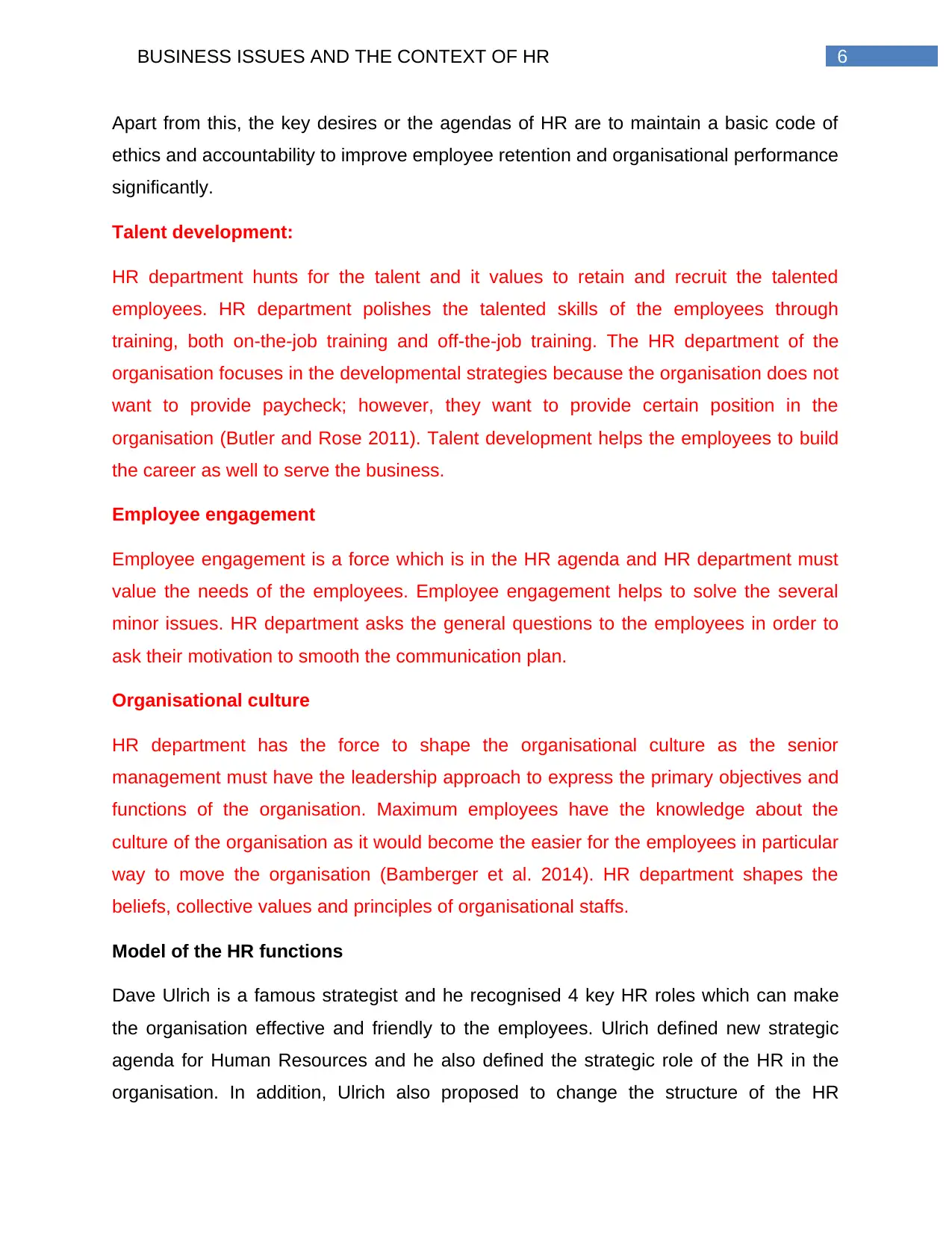
6BUSINESS ISSUES AND THE CONTEXT OF HR
Apart from this, the key desires or the agendas of HR are to maintain a basic code of
ethics and accountability to improve employee retention and organisational performance
significantly.
Talent development:
HR department hunts for the talent and it values to retain and recruit the talented
employees. HR department polishes the talented skills of the employees through
training, both on-the-job training and off-the-job training. The HR department of the
organisation focuses in the developmental strategies because the organisation does not
want to provide paycheck; however, they want to provide certain position in the
organisation (Butler and Rose 2011). Talent development helps the employees to build
the career as well to serve the business.
Employee engagement
Employee engagement is a force which is in the HR agenda and HR department must
value the needs of the employees. Employee engagement helps to solve the several
minor issues. HR department asks the general questions to the employees in order to
ask their motivation to smooth the communication plan.
Organisational culture
HR department has the force to shape the organisational culture as the senior
management must have the leadership approach to express the primary objectives and
functions of the organisation. Maximum employees have the knowledge about the
culture of the organisation as it would become the easier for the employees in particular
way to move the organisation (Bamberger et al. 2014). HR department shapes the
beliefs, collective values and principles of organisational staffs.
Model of the HR functions
Dave Ulrich is a famous strategist and he recognised 4 key HR roles which can make
the organisation effective and friendly to the employees. Ulrich defined new strategic
agenda for Human Resources and he also defined the strategic role of the HR in the
organisation. In addition, Ulrich also proposed to change the structure of the HR
Apart from this, the key desires or the agendas of HR are to maintain a basic code of
ethics and accountability to improve employee retention and organisational performance
significantly.
Talent development:
HR department hunts for the talent and it values to retain and recruit the talented
employees. HR department polishes the talented skills of the employees through
training, both on-the-job training and off-the-job training. The HR department of the
organisation focuses in the developmental strategies because the organisation does not
want to provide paycheck; however, they want to provide certain position in the
organisation (Butler and Rose 2011). Talent development helps the employees to build
the career as well to serve the business.
Employee engagement
Employee engagement is a force which is in the HR agenda and HR department must
value the needs of the employees. Employee engagement helps to solve the several
minor issues. HR department asks the general questions to the employees in order to
ask their motivation to smooth the communication plan.
Organisational culture
HR department has the force to shape the organisational culture as the senior
management must have the leadership approach to express the primary objectives and
functions of the organisation. Maximum employees have the knowledge about the
culture of the organisation as it would become the easier for the employees in particular
way to move the organisation (Bamberger et al. 2014). HR department shapes the
beliefs, collective values and principles of organisational staffs.
Model of the HR functions
Dave Ulrich is a famous strategist and he recognised 4 key HR roles which can make
the organisation effective and friendly to the employees. Ulrich defined new strategic
agenda for Human Resources and he also defined the strategic role of the HR in the
organisation. In addition, Ulrich also proposed to change the structure of the HR
Paraphrase This Document
Need a fresh take? Get an instant paraphrase of this document with our AI Paraphraser
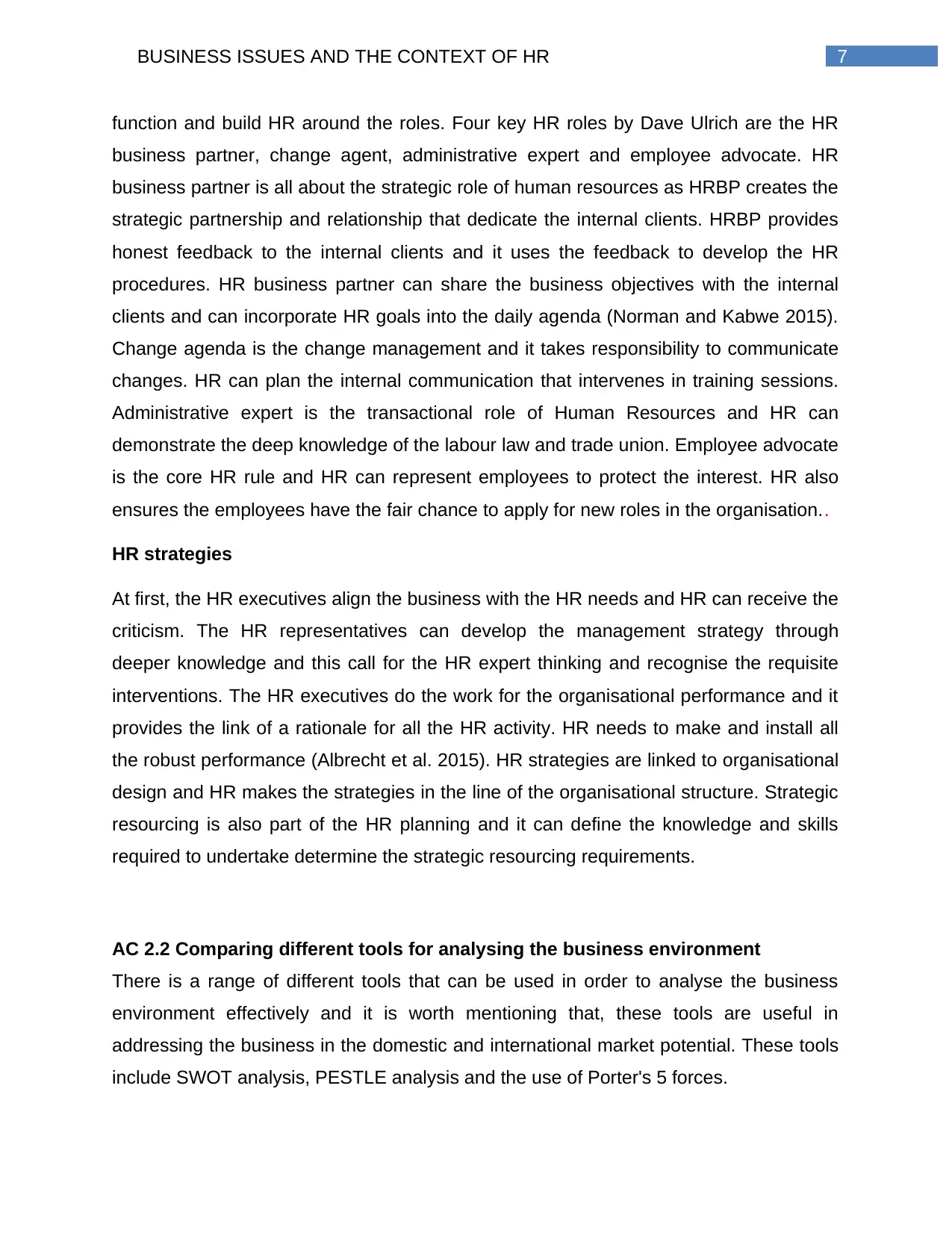
7BUSINESS ISSUES AND THE CONTEXT OF HR
function and build HR around the roles. Four key HR roles by Dave Ulrich are the HR
business partner, change agent, administrative expert and employee advocate. HR
business partner is all about the strategic role of human resources as HRBP creates the
strategic partnership and relationship that dedicate the internal clients. HRBP provides
honest feedback to the internal clients and it uses the feedback to develop the HR
procedures. HR business partner can share the business objectives with the internal
clients and can incorporate HR goals into the daily agenda (Norman and Kabwe 2015).
Change agenda is the change management and it takes responsibility to communicate
changes. HR can plan the internal communication that intervenes in training sessions.
Administrative expert is the transactional role of Human Resources and HR can
demonstrate the deep knowledge of the labour law and trade union. Employee advocate
is the core HR rule and HR can represent employees to protect the interest. HR also
ensures the employees have the fair chance to apply for new roles in the organisation..
HR strategies
At first, the HR executives align the business with the HR needs and HR can receive the
criticism. The HR representatives can develop the management strategy through
deeper knowledge and this call for the HR expert thinking and recognise the requisite
interventions. The HR executives do the work for the organisational performance and it
provides the link of a rationale for all the HR activity. HR needs to make and install all
the robust performance (Albrecht et al. 2015). HR strategies are linked to organisational
design and HR makes the strategies in the line of the organisational structure. Strategic
resourcing is also part of the HR planning and it can define the knowledge and skills
required to undertake determine the strategic resourcing requirements.
AC 2.2 Comparing different tools for analysing the business environment
There is a range of different tools that can be used in order to analyse the business
environment effectively and it is worth mentioning that, these tools are useful in
addressing the business in the domestic and international market potential. These tools
include SWOT analysis, PESTLE analysis and the use of Porter's 5 forces.
function and build HR around the roles. Four key HR roles by Dave Ulrich are the HR
business partner, change agent, administrative expert and employee advocate. HR
business partner is all about the strategic role of human resources as HRBP creates the
strategic partnership and relationship that dedicate the internal clients. HRBP provides
honest feedback to the internal clients and it uses the feedback to develop the HR
procedures. HR business partner can share the business objectives with the internal
clients and can incorporate HR goals into the daily agenda (Norman and Kabwe 2015).
Change agenda is the change management and it takes responsibility to communicate
changes. HR can plan the internal communication that intervenes in training sessions.
Administrative expert is the transactional role of Human Resources and HR can
demonstrate the deep knowledge of the labour law and trade union. Employee advocate
is the core HR rule and HR can represent employees to protect the interest. HR also
ensures the employees have the fair chance to apply for new roles in the organisation..
HR strategies
At first, the HR executives align the business with the HR needs and HR can receive the
criticism. The HR representatives can develop the management strategy through
deeper knowledge and this call for the HR expert thinking and recognise the requisite
interventions. The HR executives do the work for the organisational performance and it
provides the link of a rationale for all the HR activity. HR needs to make and install all
the robust performance (Albrecht et al. 2015). HR strategies are linked to organisational
design and HR makes the strategies in the line of the organisational structure. Strategic
resourcing is also part of the HR planning and it can define the knowledge and skills
required to undertake determine the strategic resourcing requirements.
AC 2.2 Comparing different tools for analysing the business environment
There is a range of different tools that can be used in order to analyse the business
environment effectively and it is worth mentioning that, these tools are useful in
addressing the business in the domestic and international market potential. These tools
include SWOT analysis, PESTLE analysis and the use of Porter's 5 forces.
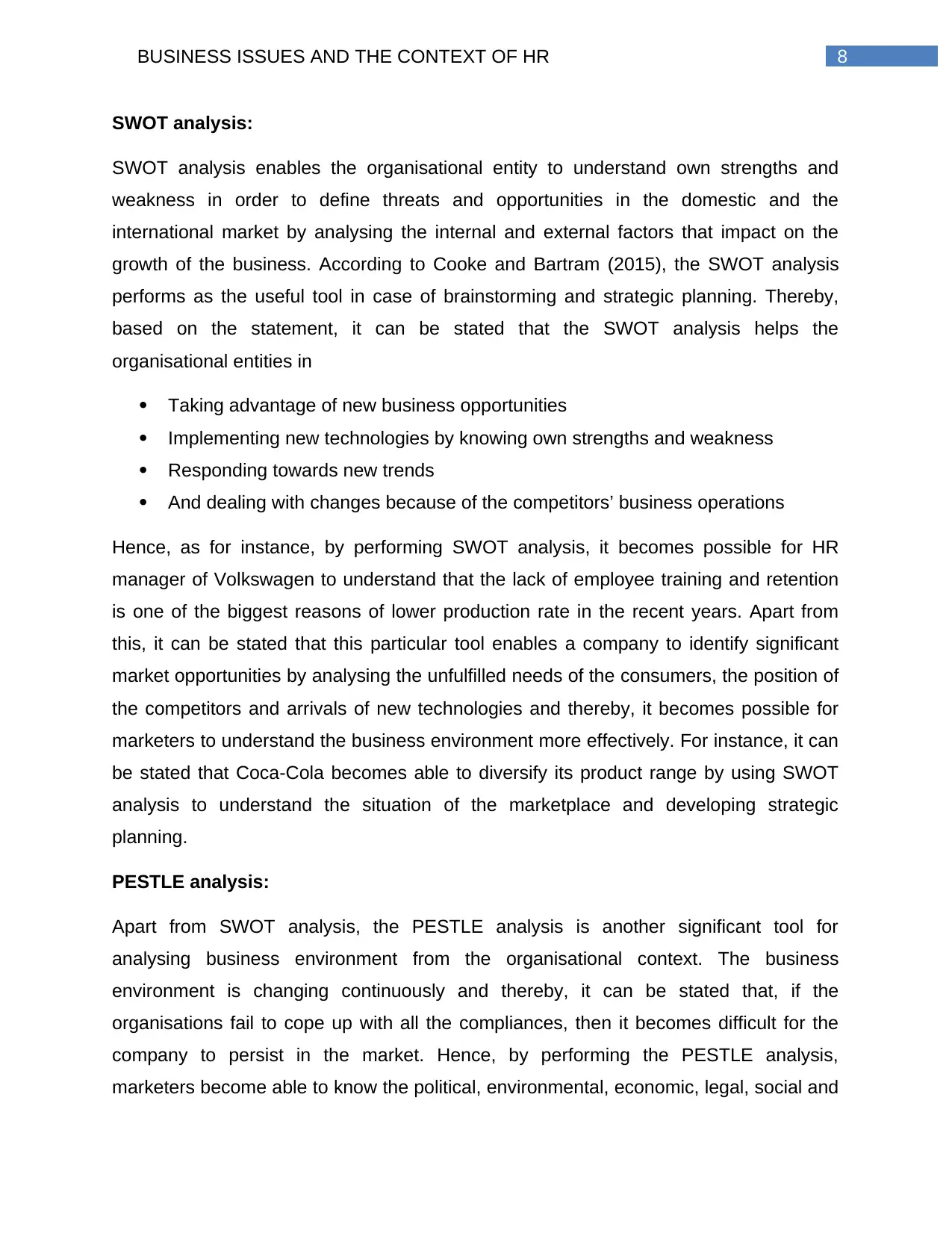
8BUSINESS ISSUES AND THE CONTEXT OF HR
SWOT analysis:
SWOT analysis enables the organisational entity to understand own strengths and
weakness in order to define threats and opportunities in the domestic and the
international market by analysing the internal and external factors that impact on the
growth of the business. According to Cooke and Bartram (2015), the SWOT analysis
performs as the useful tool in case of brainstorming and strategic planning. Thereby,
based on the statement, it can be stated that the SWOT analysis helps the
organisational entities in
Taking advantage of new business opportunities
Implementing new technologies by knowing own strengths and weakness
Responding towards new trends
And dealing with changes because of the competitors’ business operations
Hence, as for instance, by performing SWOT analysis, it becomes possible for HR
manager of Volkswagen to understand that the lack of employee training and retention
is one of the biggest reasons of lower production rate in the recent years. Apart from
this, it can be stated that this particular tool enables a company to identify significant
market opportunities by analysing the unfulfilled needs of the consumers, the position of
the competitors and arrivals of new technologies and thereby, it becomes possible for
marketers to understand the business environment more effectively. For instance, it can
be stated that Coca-Cola becomes able to diversify its product range by using SWOT
analysis to understand the situation of the marketplace and developing strategic
planning.
PESTLE analysis:
Apart from SWOT analysis, the PESTLE analysis is another significant tool for
analysing business environment from the organisational context. The business
environment is changing continuously and thereby, it can be stated that, if the
organisations fail to cope up with all the compliances, then it becomes difficult for the
company to persist in the market. Hence, by performing the PESTLE analysis,
marketers become able to know the political, environmental, economic, legal, social and
SWOT analysis:
SWOT analysis enables the organisational entity to understand own strengths and
weakness in order to define threats and opportunities in the domestic and the
international market by analysing the internal and external factors that impact on the
growth of the business. According to Cooke and Bartram (2015), the SWOT analysis
performs as the useful tool in case of brainstorming and strategic planning. Thereby,
based on the statement, it can be stated that the SWOT analysis helps the
organisational entities in
Taking advantage of new business opportunities
Implementing new technologies by knowing own strengths and weakness
Responding towards new trends
And dealing with changes because of the competitors’ business operations
Hence, as for instance, by performing SWOT analysis, it becomes possible for HR
manager of Volkswagen to understand that the lack of employee training and retention
is one of the biggest reasons of lower production rate in the recent years. Apart from
this, it can be stated that this particular tool enables a company to identify significant
market opportunities by analysing the unfulfilled needs of the consumers, the position of
the competitors and arrivals of new technologies and thereby, it becomes possible for
marketers to understand the business environment more effectively. For instance, it can
be stated that Coca-Cola becomes able to diversify its product range by using SWOT
analysis to understand the situation of the marketplace and developing strategic
planning.
PESTLE analysis:
Apart from SWOT analysis, the PESTLE analysis is another significant tool for
analysing business environment from the organisational context. The business
environment is changing continuously and thereby, it can be stated that, if the
organisations fail to cope up with all the compliances, then it becomes difficult for the
company to persist in the market. Hence, by performing the PESTLE analysis,
marketers become able to know the political, environmental, economic, legal, social and
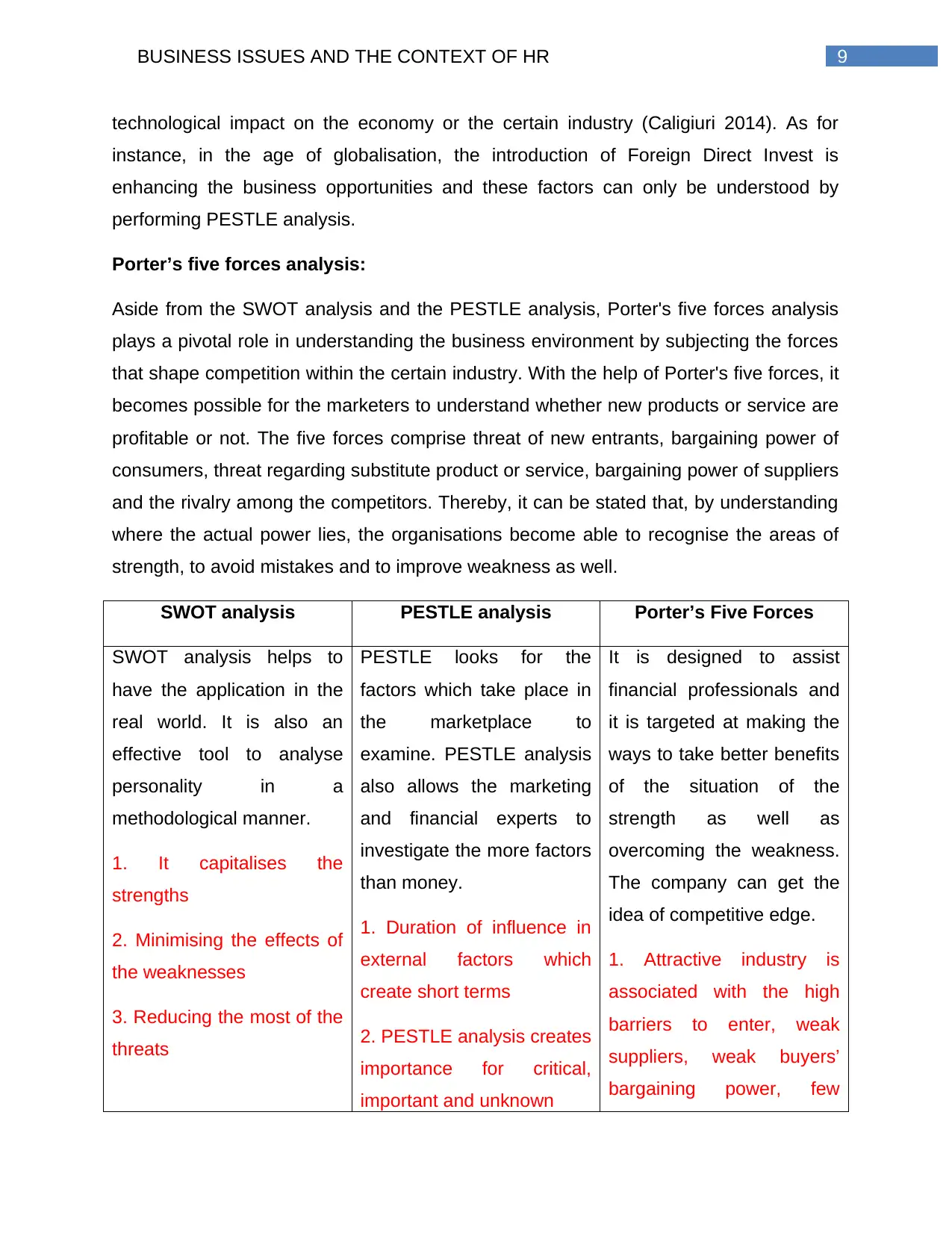
9BUSINESS ISSUES AND THE CONTEXT OF HR
technological impact on the economy or the certain industry (Caligiuri 2014). As for
instance, in the age of globalisation, the introduction of Foreign Direct Invest is
enhancing the business opportunities and these factors can only be understood by
performing PESTLE analysis.
Porter’s five forces analysis:
Aside from the SWOT analysis and the PESTLE analysis, Porter's five forces analysis
plays a pivotal role in understanding the business environment by subjecting the forces
that shape competition within the certain industry. With the help of Porter's five forces, it
becomes possible for the marketers to understand whether new products or service are
profitable or not. The five forces comprise threat of new entrants, bargaining power of
consumers, threat regarding substitute product or service, bargaining power of suppliers
and the rivalry among the competitors. Thereby, it can be stated that, by understanding
where the actual power lies, the organisations become able to recognise the areas of
strength, to avoid mistakes and to improve weakness as well.
SWOT analysis PESTLE analysis Porter’s Five Forces
SWOT analysis helps to
have the application in the
real world. It is also an
effective tool to analyse
personality in a
methodological manner.
1. It capitalises the
strengths
2. Minimising the effects of
the weaknesses
3. Reducing the most of the
threats
PESTLE looks for the
factors which take place in
the marketplace to
examine. PESTLE analysis
also allows the marketing
and financial experts to
investigate the more factors
than money.
1. Duration of influence in
external factors which
create short terms
2. PESTLE analysis creates
importance for critical,
important and unknown
It is designed to assist
financial professionals and
it is targeted at making the
ways to take better benefits
of the situation of the
strength as well as
overcoming the weakness.
The company can get the
idea of competitive edge.
1. Attractive industry is
associated with the high
barriers to enter, weak
suppliers, weak buyers’
bargaining power, few
technological impact on the economy or the certain industry (Caligiuri 2014). As for
instance, in the age of globalisation, the introduction of Foreign Direct Invest is
enhancing the business opportunities and these factors can only be understood by
performing PESTLE analysis.
Porter’s five forces analysis:
Aside from the SWOT analysis and the PESTLE analysis, Porter's five forces analysis
plays a pivotal role in understanding the business environment by subjecting the forces
that shape competition within the certain industry. With the help of Porter's five forces, it
becomes possible for the marketers to understand whether new products or service are
profitable or not. The five forces comprise threat of new entrants, bargaining power of
consumers, threat regarding substitute product or service, bargaining power of suppliers
and the rivalry among the competitors. Thereby, it can be stated that, by understanding
where the actual power lies, the organisations become able to recognise the areas of
strength, to avoid mistakes and to improve weakness as well.
SWOT analysis PESTLE analysis Porter’s Five Forces
SWOT analysis helps to
have the application in the
real world. It is also an
effective tool to analyse
personality in a
methodological manner.
1. It capitalises the
strengths
2. Minimising the effects of
the weaknesses
3. Reducing the most of the
threats
PESTLE looks for the
factors which take place in
the marketplace to
examine. PESTLE analysis
also allows the marketing
and financial experts to
investigate the more factors
than money.
1. Duration of influence in
external factors which
create short terms
2. PESTLE analysis creates
importance for critical,
important and unknown
It is designed to assist
financial professionals and
it is targeted at making the
ways to take better benefits
of the situation of the
strength as well as
overcoming the weakness.
The company can get the
idea of competitive edge.
1. Attractive industry is
associated with the high
barriers to enter, weak
suppliers, weak buyers’
bargaining power, few
Secure Best Marks with AI Grader
Need help grading? Try our AI Grader for instant feedback on your assignments.
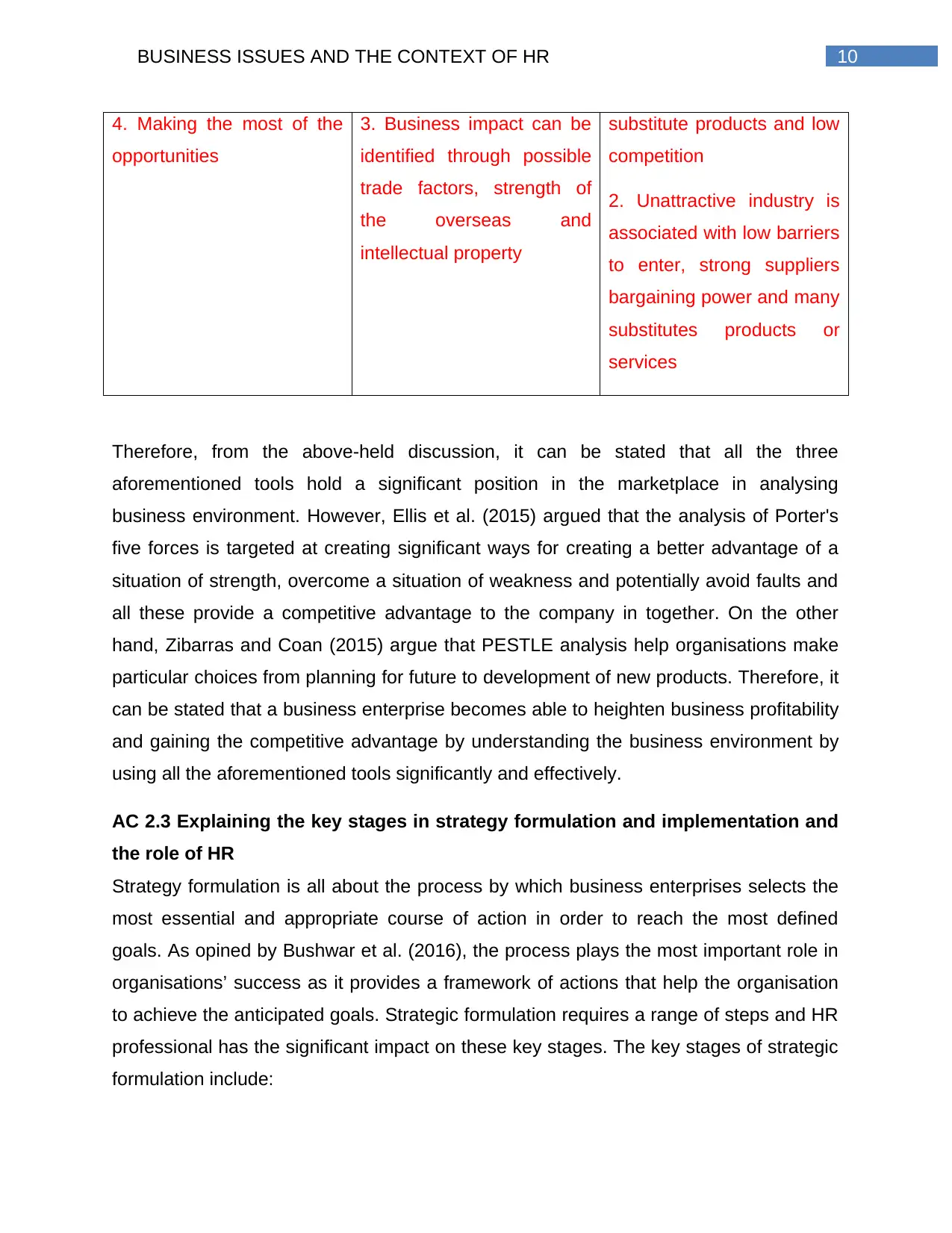
10BUSINESS ISSUES AND THE CONTEXT OF HR
4. Making the most of the
opportunities
3. Business impact can be
identified through possible
trade factors, strength of
the overseas and
intellectual property
substitute products and low
competition
2. Unattractive industry is
associated with low barriers
to enter, strong suppliers
bargaining power and many
substitutes products or
services
Therefore, from the above-held discussion, it can be stated that all the three
aforementioned tools hold a significant position in the marketplace in analysing
business environment. However, Ellis et al. (2015) argued that the analysis of Porter's
five forces is targeted at creating significant ways for creating a better advantage of a
situation of strength, overcome a situation of weakness and potentially avoid faults and
all these provide a competitive advantage to the company in together. On the other
hand, Zibarras and Coan (2015) argue that PESTLE analysis help organisations make
particular choices from planning for future to development of new products. Therefore, it
can be stated that a business enterprise becomes able to heighten business profitability
and gaining the competitive advantage by understanding the business environment by
using all the aforementioned tools significantly and effectively.
AC 2.3 Explaining the key stages in strategy formulation and implementation and
the role of HR
Strategy formulation is all about the process by which business enterprises selects the
most essential and appropriate course of action in order to reach the most defined
goals. As opined by Bushwar et al. (2016), the process plays the most important role in
organisations’ success as it provides a framework of actions that help the organisation
to achieve the anticipated goals. Strategic formulation requires a range of steps and HR
professional has the significant impact on these key stages. The key stages of strategic
formulation include:
4. Making the most of the
opportunities
3. Business impact can be
identified through possible
trade factors, strength of
the overseas and
intellectual property
substitute products and low
competition
2. Unattractive industry is
associated with low barriers
to enter, strong suppliers
bargaining power and many
substitutes products or
services
Therefore, from the above-held discussion, it can be stated that all the three
aforementioned tools hold a significant position in the marketplace in analysing
business environment. However, Ellis et al. (2015) argued that the analysis of Porter's
five forces is targeted at creating significant ways for creating a better advantage of a
situation of strength, overcome a situation of weakness and potentially avoid faults and
all these provide a competitive advantage to the company in together. On the other
hand, Zibarras and Coan (2015) argue that PESTLE analysis help organisations make
particular choices from planning for future to development of new products. Therefore, it
can be stated that a business enterprise becomes able to heighten business profitability
and gaining the competitive advantage by understanding the business environment by
using all the aforementioned tools significantly and effectively.
AC 2.3 Explaining the key stages in strategy formulation and implementation and
the role of HR
Strategy formulation is all about the process by which business enterprises selects the
most essential and appropriate course of action in order to reach the most defined
goals. As opined by Bushwar et al. (2016), the process plays the most important role in
organisations’ success as it provides a framework of actions that help the organisation
to achieve the anticipated goals. Strategic formulation requires a range of steps and HR
professional has the significant impact on these key stages. The key stages of strategic
formulation include:
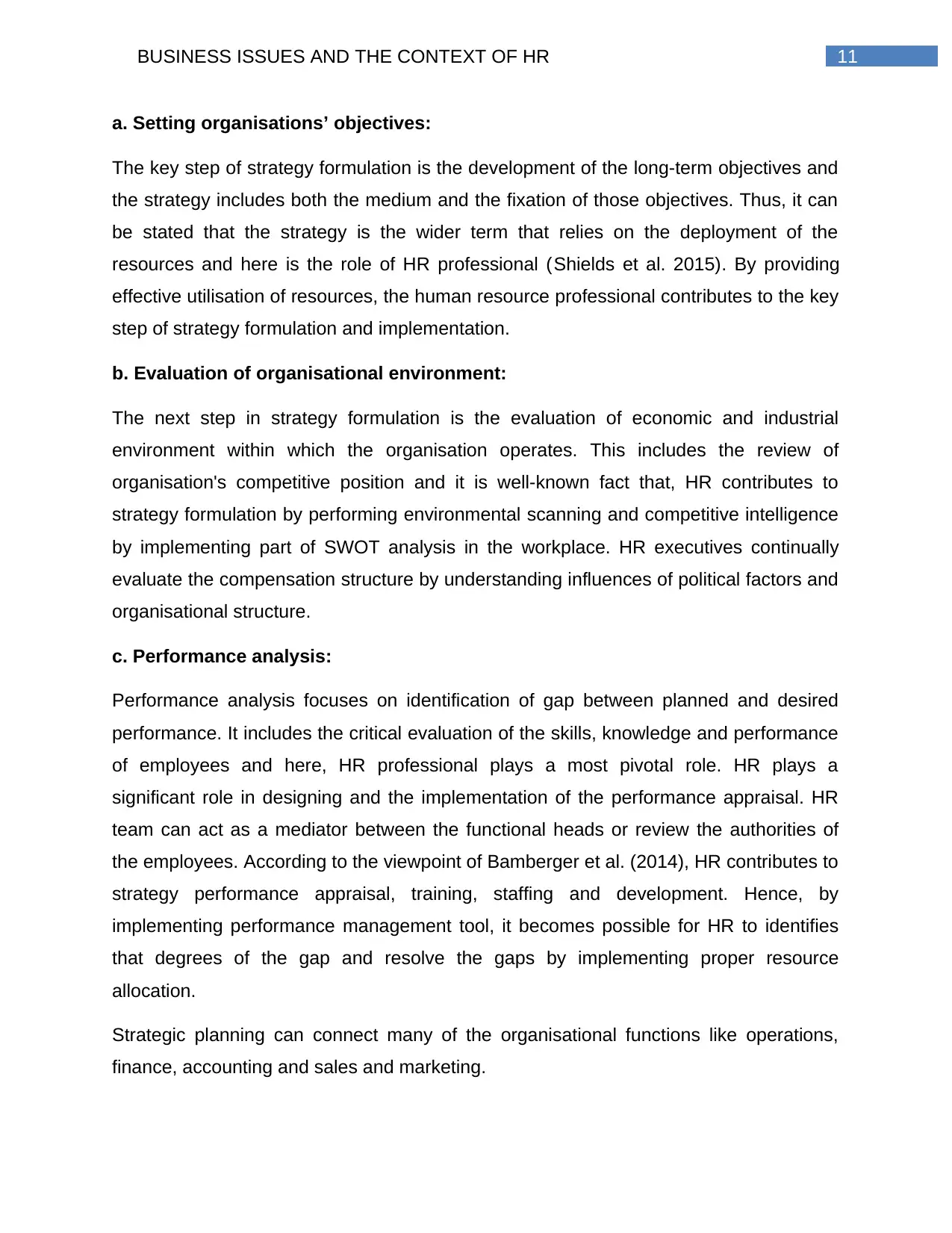
11BUSINESS ISSUES AND THE CONTEXT OF HR
a. Setting organisations’ objectives:
The key step of strategy formulation is the development of the long-term objectives and
the strategy includes both the medium and the fixation of those objectives. Thus, it can
be stated that the strategy is the wider term that relies on the deployment of the
resources and here is the role of HR professional (Shields et al. 2015). By providing
effective utilisation of resources, the human resource professional contributes to the key
step of strategy formulation and implementation.
b. Evaluation of organisational environment:
The next step in strategy formulation is the evaluation of economic and industrial
environment within which the organisation operates. This includes the review of
organisation's competitive position and it is well-known fact that, HR contributes to
strategy formulation by performing environmental scanning and competitive intelligence
by implementing part of SWOT analysis in the workplace. HR executives continually
evaluate the compensation structure by understanding influences of political factors and
organisational structure.
c. Performance analysis:
Performance analysis focuses on identification of gap between planned and desired
performance. It includes the critical evaluation of the skills, knowledge and performance
of employees and here, HR professional plays a most pivotal role. HR plays a
significant role in designing and the implementation of the performance appraisal. HR
team can act as a mediator between the functional heads or review the authorities of
the employees. According to the viewpoint of Bamberger et al. (2014), HR contributes to
strategy performance appraisal, training, staffing and development. Hence, by
implementing performance management tool, it becomes possible for HR to identifies
that degrees of the gap and resolve the gaps by implementing proper resource
allocation.
Strategic planning can connect many of the organisational functions like operations,
finance, accounting and sales and marketing.
a. Setting organisations’ objectives:
The key step of strategy formulation is the development of the long-term objectives and
the strategy includes both the medium and the fixation of those objectives. Thus, it can
be stated that the strategy is the wider term that relies on the deployment of the
resources and here is the role of HR professional (Shields et al. 2015). By providing
effective utilisation of resources, the human resource professional contributes to the key
step of strategy formulation and implementation.
b. Evaluation of organisational environment:
The next step in strategy formulation is the evaluation of economic and industrial
environment within which the organisation operates. This includes the review of
organisation's competitive position and it is well-known fact that, HR contributes to
strategy formulation by performing environmental scanning and competitive intelligence
by implementing part of SWOT analysis in the workplace. HR executives continually
evaluate the compensation structure by understanding influences of political factors and
organisational structure.
c. Performance analysis:
Performance analysis focuses on identification of gap between planned and desired
performance. It includes the critical evaluation of the skills, knowledge and performance
of employees and here, HR professional plays a most pivotal role. HR plays a
significant role in designing and the implementation of the performance appraisal. HR
team can act as a mediator between the functional heads or review the authorities of
the employees. According to the viewpoint of Bamberger et al. (2014), HR contributes to
strategy performance appraisal, training, staffing and development. Hence, by
implementing performance management tool, it becomes possible for HR to identifies
that degrees of the gap and resolve the gaps by implementing proper resource
allocation.
Strategic planning can connect many of the organisational functions like operations,
finance, accounting and sales and marketing.
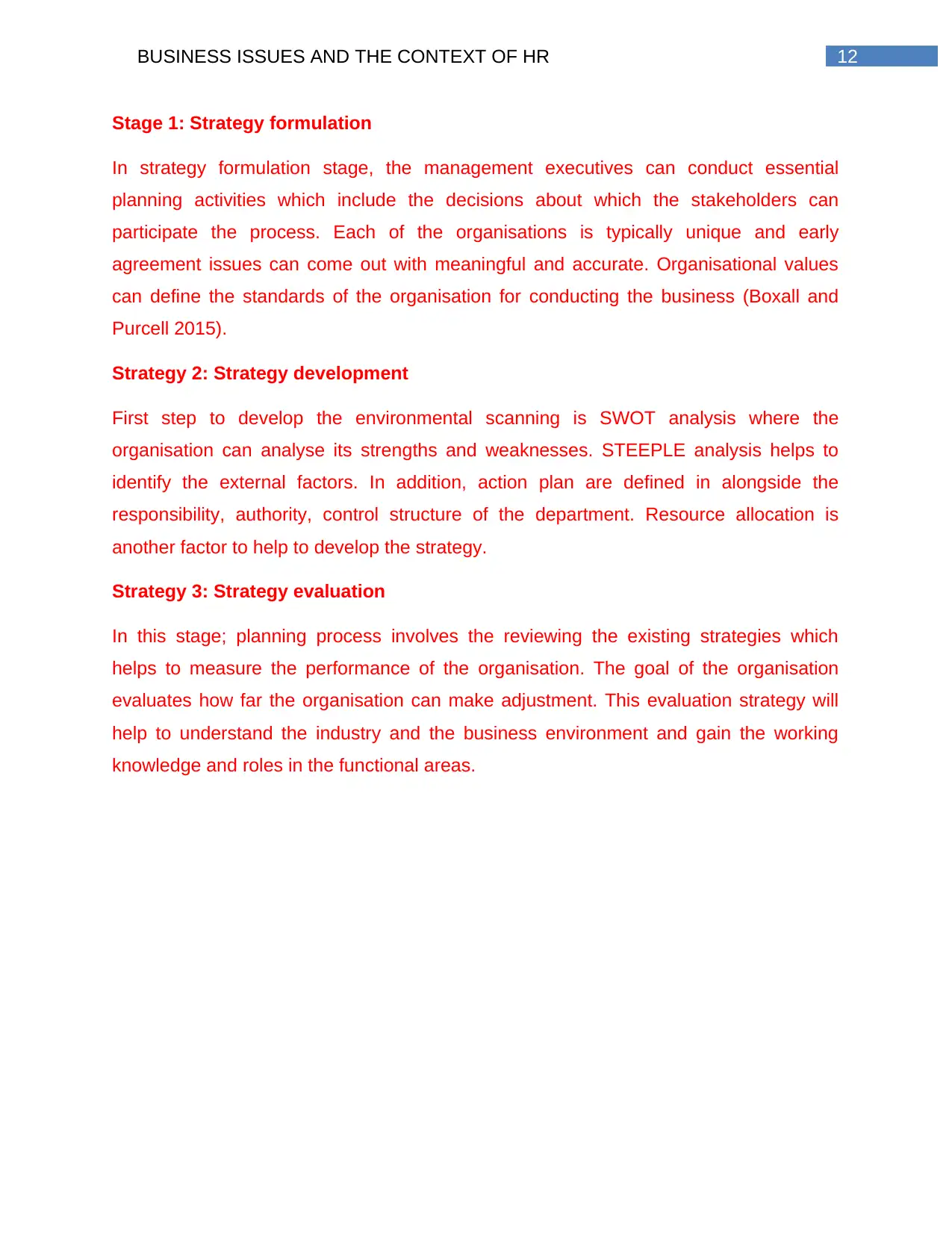
12BUSINESS ISSUES AND THE CONTEXT OF HR
Stage 1: Strategy formulation
In strategy formulation stage, the management executives can conduct essential
planning activities which include the decisions about which the stakeholders can
participate the process. Each of the organisations is typically unique and early
agreement issues can come out with meaningful and accurate. Organisational values
can define the standards of the organisation for conducting the business (Boxall and
Purcell 2015).
Strategy 2: Strategy development
First step to develop the environmental scanning is SWOT analysis where the
organisation can analyse its strengths and weaknesses. STEEPLE analysis helps to
identify the external factors. In addition, action plan are defined in alongside the
responsibility, authority, control structure of the department. Resource allocation is
another factor to help to develop the strategy.
Strategy 3: Strategy evaluation
In this stage; planning process involves the reviewing the existing strategies which
helps to measure the performance of the organisation. The goal of the organisation
evaluates how far the organisation can make adjustment. This evaluation strategy will
help to understand the industry and the business environment and gain the working
knowledge and roles in the functional areas.
Stage 1: Strategy formulation
In strategy formulation stage, the management executives can conduct essential
planning activities which include the decisions about which the stakeholders can
participate the process. Each of the organisations is typically unique and early
agreement issues can come out with meaningful and accurate. Organisational values
can define the standards of the organisation for conducting the business (Boxall and
Purcell 2015).
Strategy 2: Strategy development
First step to develop the environmental scanning is SWOT analysis where the
organisation can analyse its strengths and weaknesses. STEEPLE analysis helps to
identify the external factors. In addition, action plan are defined in alongside the
responsibility, authority, control structure of the department. Resource allocation is
another factor to help to develop the strategy.
Strategy 3: Strategy evaluation
In this stage; planning process involves the reviewing the existing strategies which
helps to measure the performance of the organisation. The goal of the organisation
evaluates how far the organisation can make adjustment. This evaluation strategy will
help to understand the industry and the business environment and gain the working
knowledge and roles in the functional areas.
Paraphrase This Document
Need a fresh take? Get an instant paraphrase of this document with our AI Paraphraser
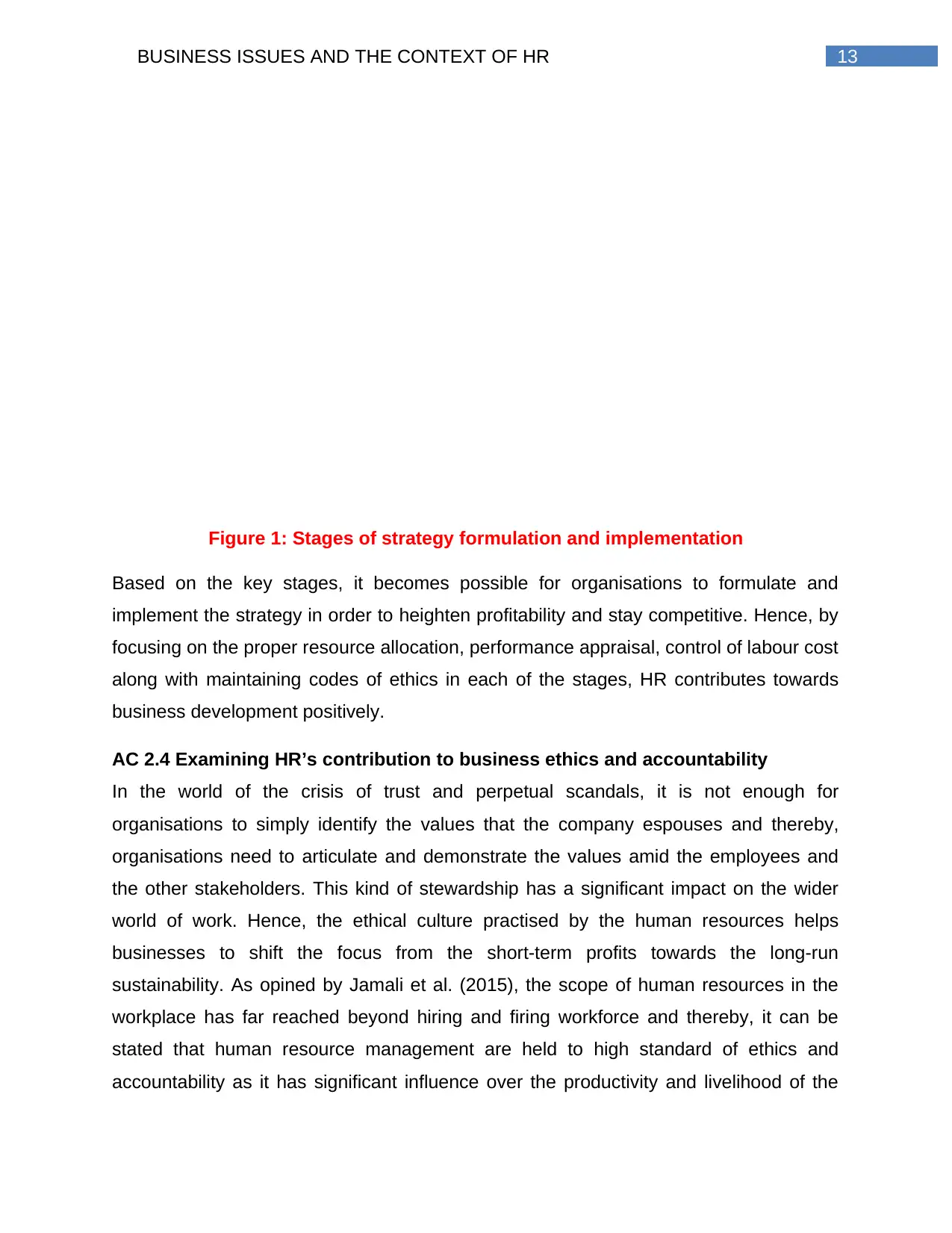
13BUSINESS ISSUES AND THE CONTEXT OF HR
Figure 1: Stages of strategy formulation and implementation
Based on the key stages, it becomes possible for organisations to formulate and
implement the strategy in order to heighten profitability and stay competitive. Hence, by
focusing on the proper resource allocation, performance appraisal, control of labour cost
along with maintaining codes of ethics in each of the stages, HR contributes towards
business development positively.
AC 2.4 Examining HR’s contribution to business ethics and accountability
In the world of the crisis of trust and perpetual scandals, it is not enough for
organisations to simply identify the values that the company espouses and thereby,
organisations need to articulate and demonstrate the values amid the employees and
the other stakeholders. This kind of stewardship has a significant impact on the wider
world of work. Hence, the ethical culture practised by the human resources helps
businesses to shift the focus from the short-term profits towards the long-run
sustainability. As opined by Jamali et al. (2015), the scope of human resources in the
workplace has far reached beyond hiring and firing workforce and thereby, it can be
stated that human resource management are held to high standard of ethics and
accountability as it has significant influence over the productivity and livelihood of the
Inthisstage;planningprocessinvolvesthereviewingtheexistingstrategieswhichhelpstomeasuretheperformanceoftheorganisation.Thisevaluationstrategywillhelptounderstandtheindustryandthebusinessenvironmentandgaintheworkingknowledgeandrolesinthefunctionalareas.
Figure 1: Stages of strategy formulation and implementation
Based on the key stages, it becomes possible for organisations to formulate and
implement the strategy in order to heighten profitability and stay competitive. Hence, by
focusing on the proper resource allocation, performance appraisal, control of labour cost
along with maintaining codes of ethics in each of the stages, HR contributes towards
business development positively.
AC 2.4 Examining HR’s contribution to business ethics and accountability
In the world of the crisis of trust and perpetual scandals, it is not enough for
organisations to simply identify the values that the company espouses and thereby,
organisations need to articulate and demonstrate the values amid the employees and
the other stakeholders. This kind of stewardship has a significant impact on the wider
world of work. Hence, the ethical culture practised by the human resources helps
businesses to shift the focus from the short-term profits towards the long-run
sustainability. As opined by Jamali et al. (2015), the scope of human resources in the
workplace has far reached beyond hiring and firing workforce and thereby, it can be
stated that human resource management are held to high standard of ethics and
accountability as it has significant influence over the productivity and livelihood of the
Inthisstage;planningprocessinvolvesthereviewingtheexistingstrategieswhichhelpstomeasuretheperformanceoftheorganisation.Thisevaluationstrategywillhelptounderstandtheindustryandthebusinessenvironmentandgaintheworkingknowledgeandrolesinthefunctionalareas.
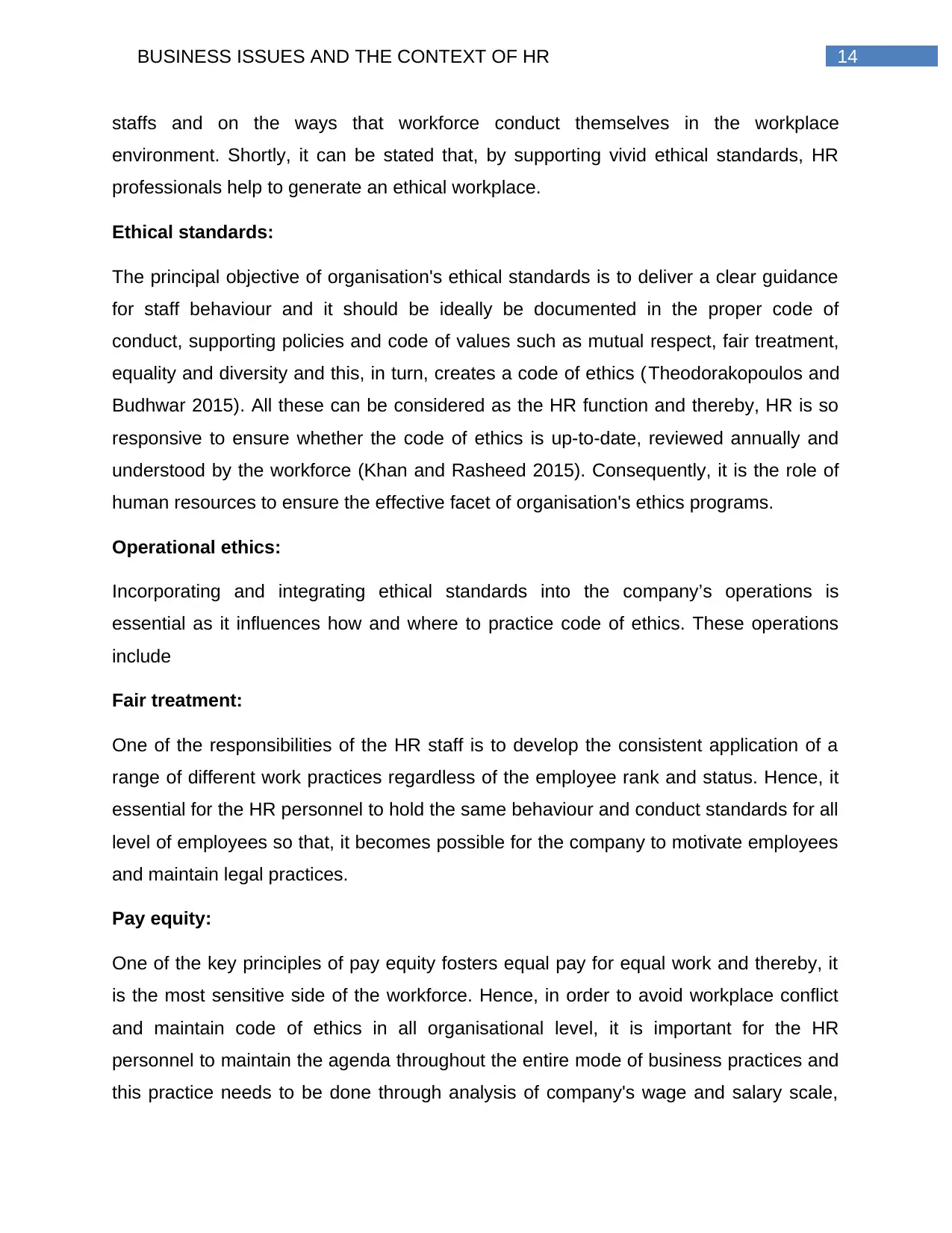
14BUSINESS ISSUES AND THE CONTEXT OF HR
staffs and on the ways that workforce conduct themselves in the workplace
environment. Shortly, it can be stated that, by supporting vivid ethical standards, HR
professionals help to generate an ethical workplace.
Ethical standards:
The principal objective of organisation's ethical standards is to deliver a clear guidance
for staff behaviour and it should be ideally be documented in the proper code of
conduct, supporting policies and code of values such as mutual respect, fair treatment,
equality and diversity and this, in turn, creates a code of ethics (Theodorakopoulos and
Budhwar 2015). All these can be considered as the HR function and thereby, HR is so
responsive to ensure whether the code of ethics is up-to-date, reviewed annually and
understood by the workforce (Khan and Rasheed 2015). Consequently, it is the role of
human resources to ensure the effective facet of organisation's ethics programs.
Operational ethics:
Incorporating and integrating ethical standards into the company’s operations is
essential as it influences how and where to practice code of ethics. These operations
include
Fair treatment:
One of the responsibilities of the HR staff is to develop the consistent application of a
range of different work practices regardless of the employee rank and status. Hence, it
essential for the HR personnel to hold the same behaviour and conduct standards for all
level of employees so that, it becomes possible for the company to motivate employees
and maintain legal practices.
Pay equity:
One of the key principles of pay equity fosters equal pay for equal work and thereby, it
is the most sensitive side of the workforce. Hence, in order to avoid workplace conflict
and maintain code of ethics in all organisational level, it is important for the HR
personnel to maintain the agenda throughout the entire mode of business practices and
this practice needs to be done through analysis of company's wage and salary scale,
staffs and on the ways that workforce conduct themselves in the workplace
environment. Shortly, it can be stated that, by supporting vivid ethical standards, HR
professionals help to generate an ethical workplace.
Ethical standards:
The principal objective of organisation's ethical standards is to deliver a clear guidance
for staff behaviour and it should be ideally be documented in the proper code of
conduct, supporting policies and code of values such as mutual respect, fair treatment,
equality and diversity and this, in turn, creates a code of ethics (Theodorakopoulos and
Budhwar 2015). All these can be considered as the HR function and thereby, HR is so
responsive to ensure whether the code of ethics is up-to-date, reviewed annually and
understood by the workforce (Khan and Rasheed 2015). Consequently, it is the role of
human resources to ensure the effective facet of organisation's ethics programs.
Operational ethics:
Incorporating and integrating ethical standards into the company’s operations is
essential as it influences how and where to practice code of ethics. These operations
include
Fair treatment:
One of the responsibilities of the HR staff is to develop the consistent application of a
range of different work practices regardless of the employee rank and status. Hence, it
essential for the HR personnel to hold the same behaviour and conduct standards for all
level of employees so that, it becomes possible for the company to motivate employees
and maintain legal practices.
Pay equity:
One of the key principles of pay equity fosters equal pay for equal work and thereby, it
is the most sensitive side of the workforce. Hence, in order to avoid workplace conflict
and maintain code of ethics in all organisational level, it is important for the HR
personnel to maintain the agenda throughout the entire mode of business practices and
this practice needs to be done through analysis of company's wage and salary scale,
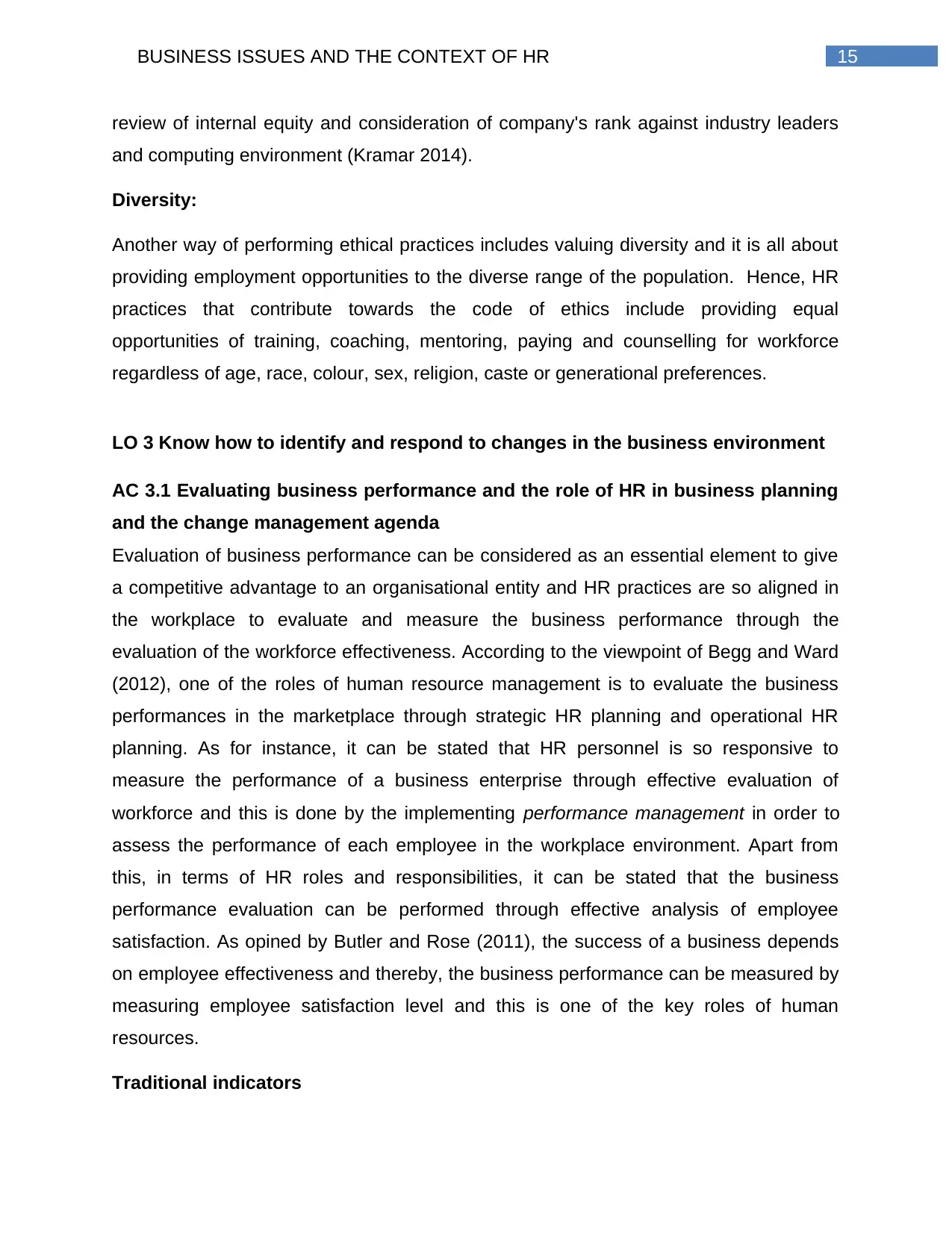
15BUSINESS ISSUES AND THE CONTEXT OF HR
review of internal equity and consideration of company's rank against industry leaders
and computing environment (Kramar 2014).
Diversity:
Another way of performing ethical practices includes valuing diversity and it is all about
providing employment opportunities to the diverse range of the population. Hence, HR
practices that contribute towards the code of ethics include providing equal
opportunities of training, coaching, mentoring, paying and counselling for workforce
regardless of age, race, colour, sex, religion, caste or generational preferences.
LO 3 Know how to identify and respond to changes in the business environment
AC 3.1 Evaluating business performance and the role of HR in business planning
and the change management agenda
Evaluation of business performance can be considered as an essential element to give
a competitive advantage to an organisational entity and HR practices are so aligned in
the workplace to evaluate and measure the business performance through the
evaluation of the workforce effectiveness. According to the viewpoint of Begg and Ward
(2012), one of the roles of human resource management is to evaluate the business
performances in the marketplace through strategic HR planning and operational HR
planning. As for instance, it can be stated that HR personnel is so responsive to
measure the performance of a business enterprise through effective evaluation of
workforce and this is done by the implementing performance management in order to
assess the performance of each employee in the workplace environment. Apart from
this, in terms of HR roles and responsibilities, it can be stated that the business
performance evaluation can be performed through effective analysis of employee
satisfaction. As opined by Butler and Rose (2011), the success of a business depends
on employee effectiveness and thereby, the business performance can be measured by
measuring employee satisfaction level and this is one of the key roles of human
resources.
Traditional indicators
review of internal equity and consideration of company's rank against industry leaders
and computing environment (Kramar 2014).
Diversity:
Another way of performing ethical practices includes valuing diversity and it is all about
providing employment opportunities to the diverse range of the population. Hence, HR
practices that contribute towards the code of ethics include providing equal
opportunities of training, coaching, mentoring, paying and counselling for workforce
regardless of age, race, colour, sex, religion, caste or generational preferences.
LO 3 Know how to identify and respond to changes in the business environment
AC 3.1 Evaluating business performance and the role of HR in business planning
and the change management agenda
Evaluation of business performance can be considered as an essential element to give
a competitive advantage to an organisational entity and HR practices are so aligned in
the workplace to evaluate and measure the business performance through the
evaluation of the workforce effectiveness. According to the viewpoint of Begg and Ward
(2012), one of the roles of human resource management is to evaluate the business
performances in the marketplace through strategic HR planning and operational HR
planning. As for instance, it can be stated that HR personnel is so responsive to
measure the performance of a business enterprise through effective evaluation of
workforce and this is done by the implementing performance management in order to
assess the performance of each employee in the workplace environment. Apart from
this, in terms of HR roles and responsibilities, it can be stated that the business
performance evaluation can be performed through effective analysis of employee
satisfaction. As opined by Butler and Rose (2011), the success of a business depends
on employee effectiveness and thereby, the business performance can be measured by
measuring employee satisfaction level and this is one of the key roles of human
resources.
Traditional indicators
Secure Best Marks with AI Grader
Need help grading? Try our AI Grader for instant feedback on your assignments.
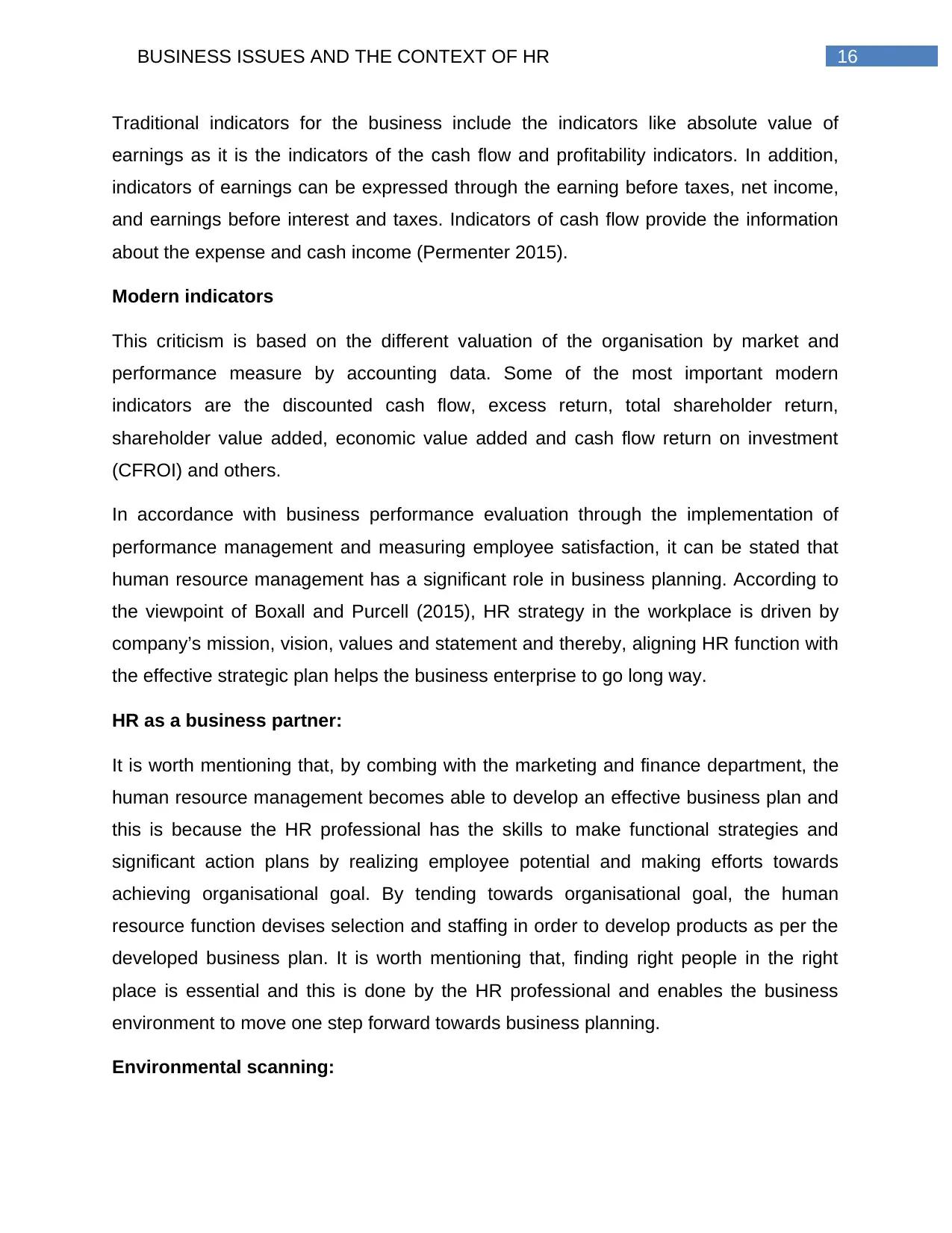
16BUSINESS ISSUES AND THE CONTEXT OF HR
Traditional indicators for the business include the indicators like absolute value of
earnings as it is the indicators of the cash flow and profitability indicators. In addition,
indicators of earnings can be expressed through the earning before taxes, net income,
and earnings before interest and taxes. Indicators of cash flow provide the information
about the expense and cash income (Permenter 2015).
Modern indicators
This criticism is based on the different valuation of the organisation by market and
performance measure by accounting data. Some of the most important modern
indicators are the discounted cash flow, excess return, total shareholder return,
shareholder value added, economic value added and cash flow return on investment
(CFROI) and others.
In accordance with business performance evaluation through the implementation of
performance management and measuring employee satisfaction, it can be stated that
human resource management has a significant role in business planning. According to
the viewpoint of Boxall and Purcell (2015), HR strategy in the workplace is driven by
company’s mission, vision, values and statement and thereby, aligning HR function with
the effective strategic plan helps the business enterprise to go long way.
HR as a business partner:
It is worth mentioning that, by combing with the marketing and finance department, the
human resource management becomes able to develop an effective business plan and
this is because the HR professional has the skills to make functional strategies and
significant action plans by realizing employee potential and making efforts towards
achieving organisational goal. By tending towards organisational goal, the human
resource function devises selection and staffing in order to develop products as per the
developed business plan. It is worth mentioning that, finding right people in the right
place is essential and this is done by the HR professional and enables the business
environment to move one step forward towards business planning.
Environmental scanning:
Traditional indicators for the business include the indicators like absolute value of
earnings as it is the indicators of the cash flow and profitability indicators. In addition,
indicators of earnings can be expressed through the earning before taxes, net income,
and earnings before interest and taxes. Indicators of cash flow provide the information
about the expense and cash income (Permenter 2015).
Modern indicators
This criticism is based on the different valuation of the organisation by market and
performance measure by accounting data. Some of the most important modern
indicators are the discounted cash flow, excess return, total shareholder return,
shareholder value added, economic value added and cash flow return on investment
(CFROI) and others.
In accordance with business performance evaluation through the implementation of
performance management and measuring employee satisfaction, it can be stated that
human resource management has a significant role in business planning. According to
the viewpoint of Boxall and Purcell (2015), HR strategy in the workplace is driven by
company’s mission, vision, values and statement and thereby, aligning HR function with
the effective strategic plan helps the business enterprise to go long way.
HR as a business partner:
It is worth mentioning that, by combing with the marketing and finance department, the
human resource management becomes able to develop an effective business plan and
this is because the HR professional has the skills to make functional strategies and
significant action plans by realizing employee potential and making efforts towards
achieving organisational goal. By tending towards organisational goal, the human
resource function devises selection and staffing in order to develop products as per the
developed business plan. It is worth mentioning that, finding right people in the right
place is essential and this is done by the HR professional and enables the business
environment to move one step forward towards business planning.
Environmental scanning:
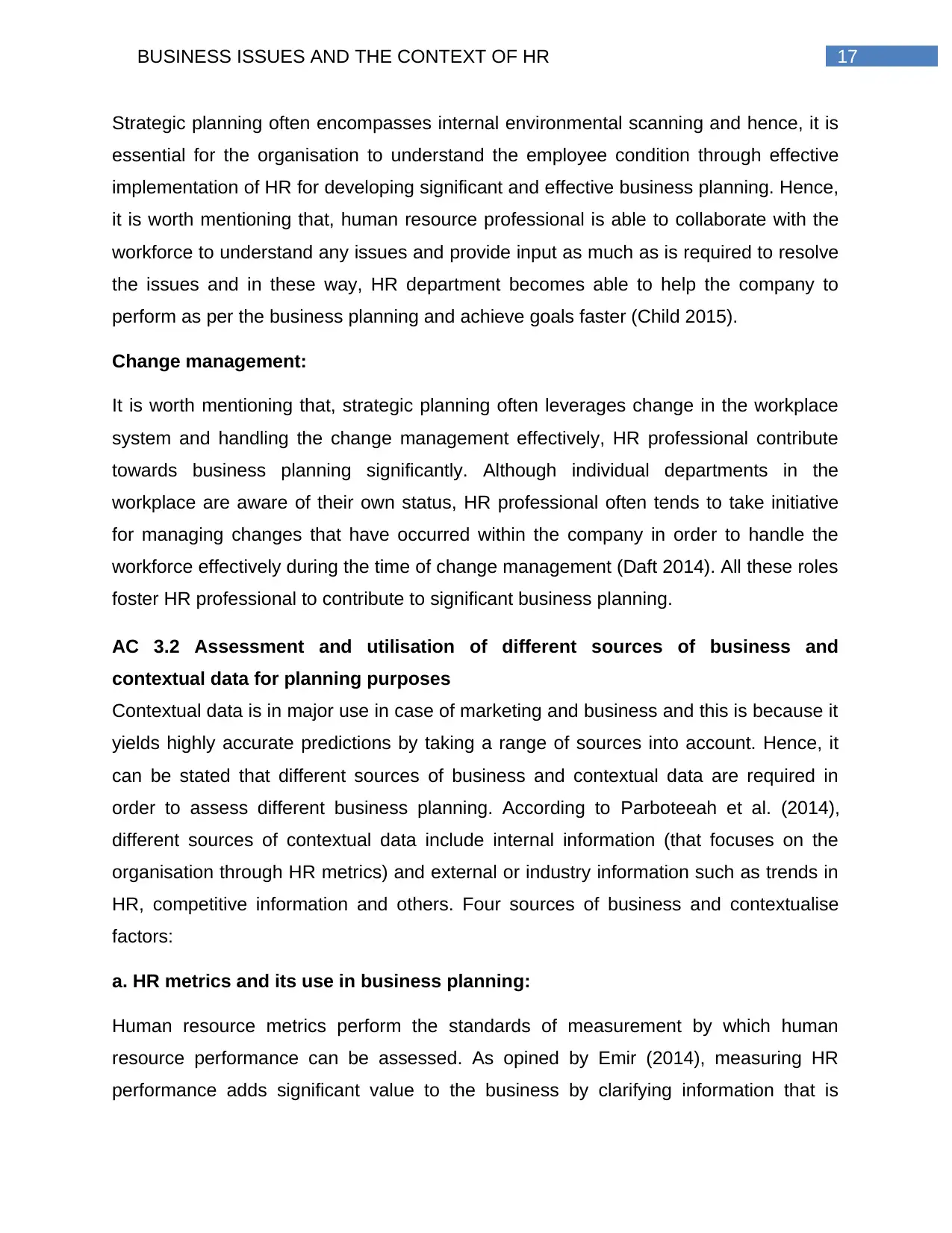
17BUSINESS ISSUES AND THE CONTEXT OF HR
Strategic planning often encompasses internal environmental scanning and hence, it is
essential for the organisation to understand the employee condition through effective
implementation of HR for developing significant and effective business planning. Hence,
it is worth mentioning that, human resource professional is able to collaborate with the
workforce to understand any issues and provide input as much as is required to resolve
the issues and in these way, HR department becomes able to help the company to
perform as per the business planning and achieve goals faster (Child 2015).
Change management:
It is worth mentioning that, strategic planning often leverages change in the workplace
system and handling the change management effectively, HR professional contribute
towards business planning significantly. Although individual departments in the
workplace are aware of their own status, HR professional often tends to take initiative
for managing changes that have occurred within the company in order to handle the
workforce effectively during the time of change management (Daft 2014). All these roles
foster HR professional to contribute to significant business planning.
AC 3.2 Assessment and utilisation of different sources of business and
contextual data for planning purposes
Contextual data is in major use in case of marketing and business and this is because it
yields highly accurate predictions by taking a range of sources into account. Hence, it
can be stated that different sources of business and contextual data are required in
order to assess different business planning. According to Parboteeah et al. (2014),
different sources of contextual data include internal information (that focuses on the
organisation through HR metrics) and external or industry information such as trends in
HR, competitive information and others. Four sources of business and contextualise
factors:
a. HR metrics and its use in business planning:
Human resource metrics perform the standards of measurement by which human
resource performance can be assessed. As opined by Emir (2014), measuring HR
performance adds significant value to the business by clarifying information that is
Strategic planning often encompasses internal environmental scanning and hence, it is
essential for the organisation to understand the employee condition through effective
implementation of HR for developing significant and effective business planning. Hence,
it is worth mentioning that, human resource professional is able to collaborate with the
workforce to understand any issues and provide input as much as is required to resolve
the issues and in these way, HR department becomes able to help the company to
perform as per the business planning and achieve goals faster (Child 2015).
Change management:
It is worth mentioning that, strategic planning often leverages change in the workplace
system and handling the change management effectively, HR professional contribute
towards business planning significantly. Although individual departments in the
workplace are aware of their own status, HR professional often tends to take initiative
for managing changes that have occurred within the company in order to handle the
workforce effectively during the time of change management (Daft 2014). All these roles
foster HR professional to contribute to significant business planning.
AC 3.2 Assessment and utilisation of different sources of business and
contextual data for planning purposes
Contextual data is in major use in case of marketing and business and this is because it
yields highly accurate predictions by taking a range of sources into account. Hence, it
can be stated that different sources of business and contextual data are required in
order to assess different business planning. According to Parboteeah et al. (2014),
different sources of contextual data include internal information (that focuses on the
organisation through HR metrics) and external or industry information such as trends in
HR, competitive information and others. Four sources of business and contextualise
factors:
a. HR metrics and its use in business planning:
Human resource metrics perform the standards of measurement by which human
resource performance can be assessed. As opined by Emir (2014), measuring HR
performance adds significant value to the business by clarifying information that is
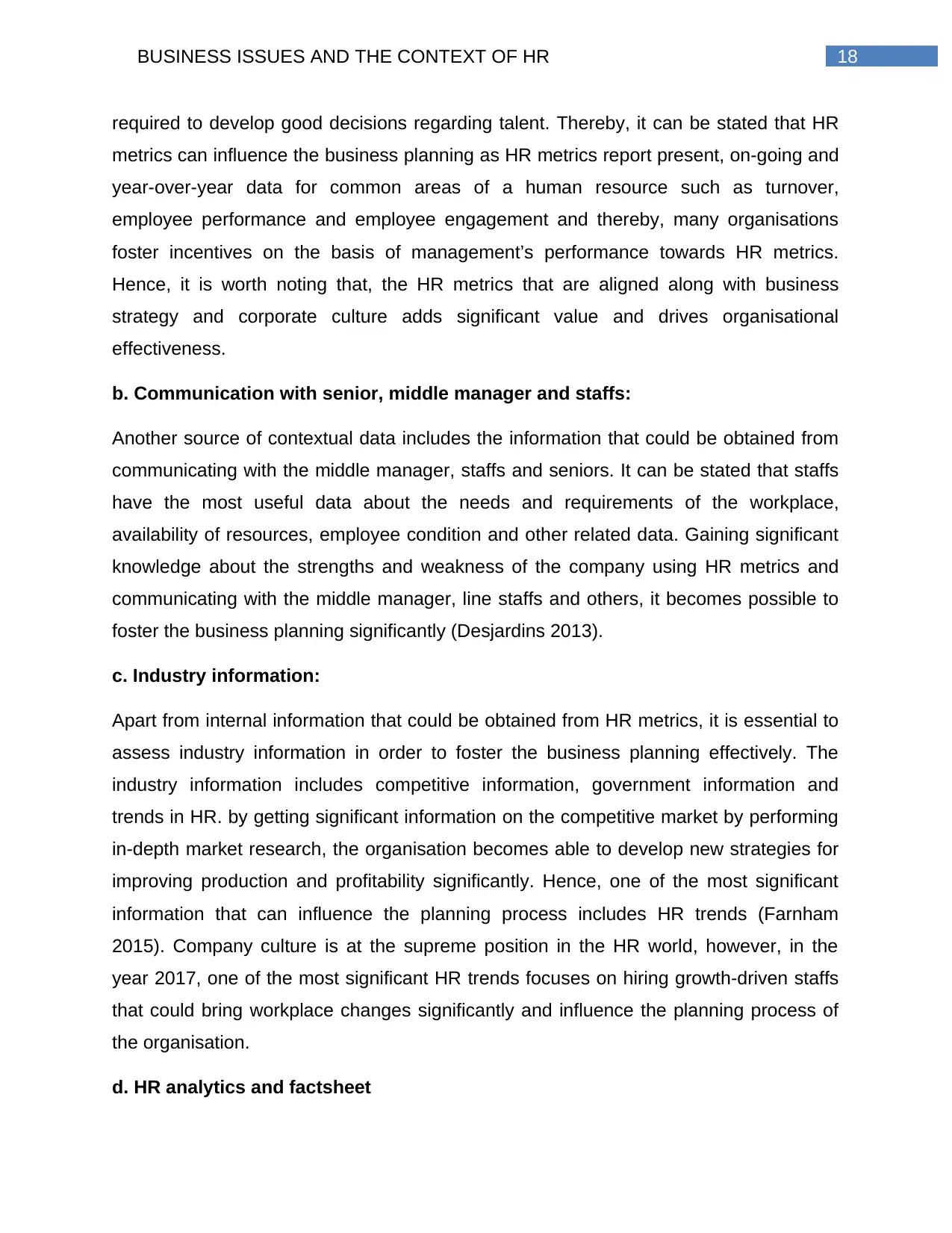
18BUSINESS ISSUES AND THE CONTEXT OF HR
required to develop good decisions regarding talent. Thereby, it can be stated that HR
metrics can influence the business planning as HR metrics report present, on-going and
year-over-year data for common areas of a human resource such as turnover,
employee performance and employee engagement and thereby, many organisations
foster incentives on the basis of management’s performance towards HR metrics.
Hence, it is worth noting that, the HR metrics that are aligned along with business
strategy and corporate culture adds significant value and drives organisational
effectiveness.
b. Communication with senior, middle manager and staffs:
Another source of contextual data includes the information that could be obtained from
communicating with the middle manager, staffs and seniors. It can be stated that staffs
have the most useful data about the needs and requirements of the workplace,
availability of resources, employee condition and other related data. Gaining significant
knowledge about the strengths and weakness of the company using HR metrics and
communicating with the middle manager, line staffs and others, it becomes possible to
foster the business planning significantly (Desjardins 2013).
c. Industry information:
Apart from internal information that could be obtained from HR metrics, it is essential to
assess industry information in order to foster the business planning effectively. The
industry information includes competitive information, government information and
trends in HR. by getting significant information on the competitive market by performing
in-depth market research, the organisation becomes able to develop new strategies for
improving production and profitability significantly. Hence, one of the most significant
information that can influence the planning process includes HR trends (Farnham
2015). Company culture is at the supreme position in the HR world, however, in the
year 2017, one of the most significant HR trends focuses on hiring growth-driven staffs
that could bring workplace changes significantly and influence the planning process of
the organisation.
d. HR analytics and factsheet
required to develop good decisions regarding talent. Thereby, it can be stated that HR
metrics can influence the business planning as HR metrics report present, on-going and
year-over-year data for common areas of a human resource such as turnover,
employee performance and employee engagement and thereby, many organisations
foster incentives on the basis of management’s performance towards HR metrics.
Hence, it is worth noting that, the HR metrics that are aligned along with business
strategy and corporate culture adds significant value and drives organisational
effectiveness.
b. Communication with senior, middle manager and staffs:
Another source of contextual data includes the information that could be obtained from
communicating with the middle manager, staffs and seniors. It can be stated that staffs
have the most useful data about the needs and requirements of the workplace,
availability of resources, employee condition and other related data. Gaining significant
knowledge about the strengths and weakness of the company using HR metrics and
communicating with the middle manager, line staffs and others, it becomes possible to
foster the business planning significantly (Desjardins 2013).
c. Industry information:
Apart from internal information that could be obtained from HR metrics, it is essential to
assess industry information in order to foster the business planning effectively. The
industry information includes competitive information, government information and
trends in HR. by getting significant information on the competitive market by performing
in-depth market research, the organisation becomes able to develop new strategies for
improving production and profitability significantly. Hence, one of the most significant
information that can influence the planning process includes HR trends (Farnham
2015). Company culture is at the supreme position in the HR world, however, in the
year 2017, one of the most significant HR trends focuses on hiring growth-driven staffs
that could bring workplace changes significantly and influence the planning process of
the organisation.
d. HR analytics and factsheet
Paraphrase This Document
Need a fresh take? Get an instant paraphrase of this document with our AI Paraphraser
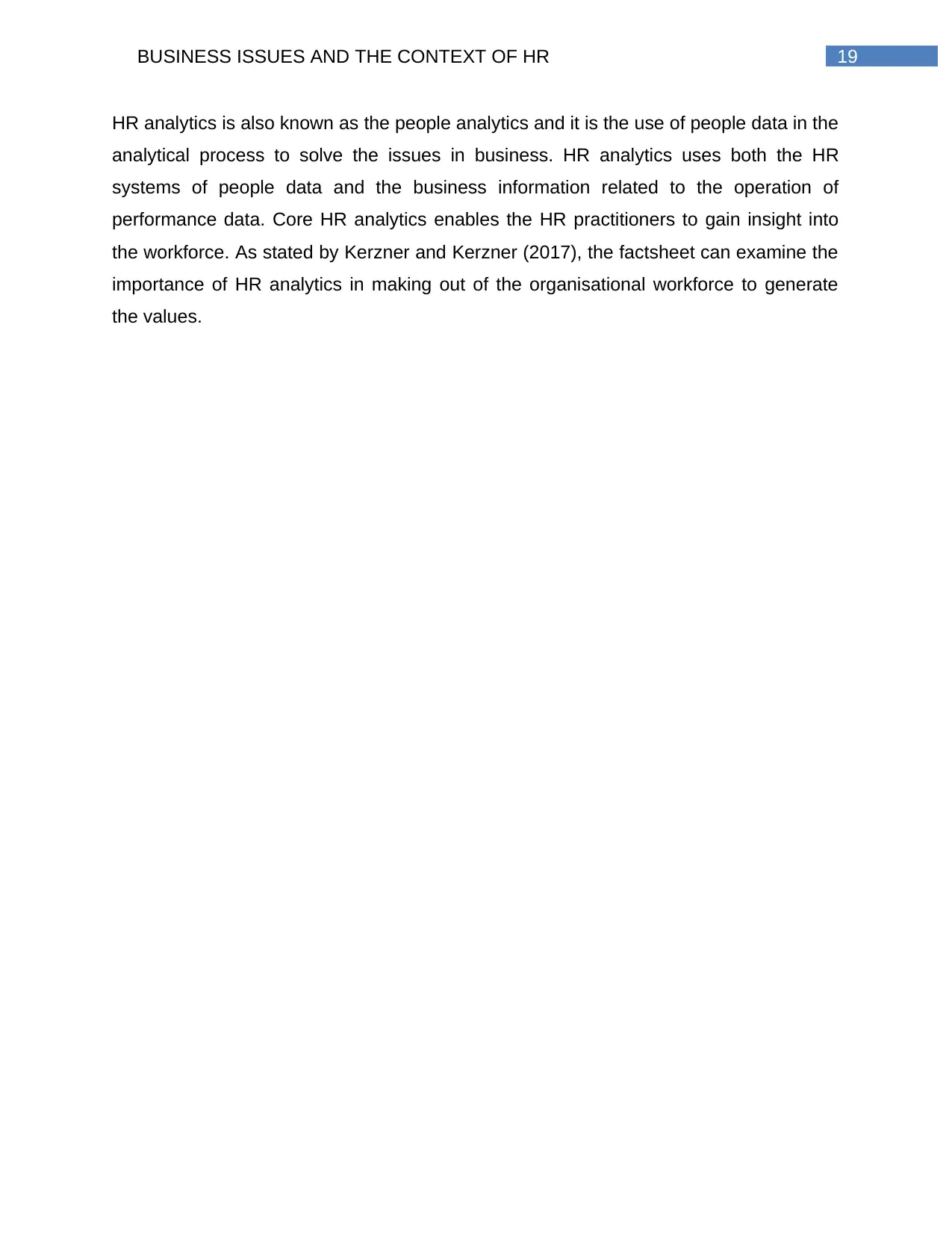
19BUSINESS ISSUES AND THE CONTEXT OF HR
HR analytics is also known as the people analytics and it is the use of people data in the
analytical process to solve the issues in business. HR analytics uses both the HR
systems of people data and the business information related to the operation of
performance data. Core HR analytics enables the HR practitioners to gain insight into
the workforce. As stated by Kerzner and Kerzner (2017), the factsheet can examine the
importance of HR analytics in making out of the organisational workforce to generate
the values.
HR analytics is also known as the people analytics and it is the use of people data in the
analytical process to solve the issues in business. HR analytics uses both the HR
systems of people data and the business information related to the operation of
performance data. Core HR analytics enables the HR practitioners to gain insight into
the workforce. As stated by Kerzner and Kerzner (2017), the factsheet can examine the
importance of HR analytics in making out of the organisational workforce to generate
the values.
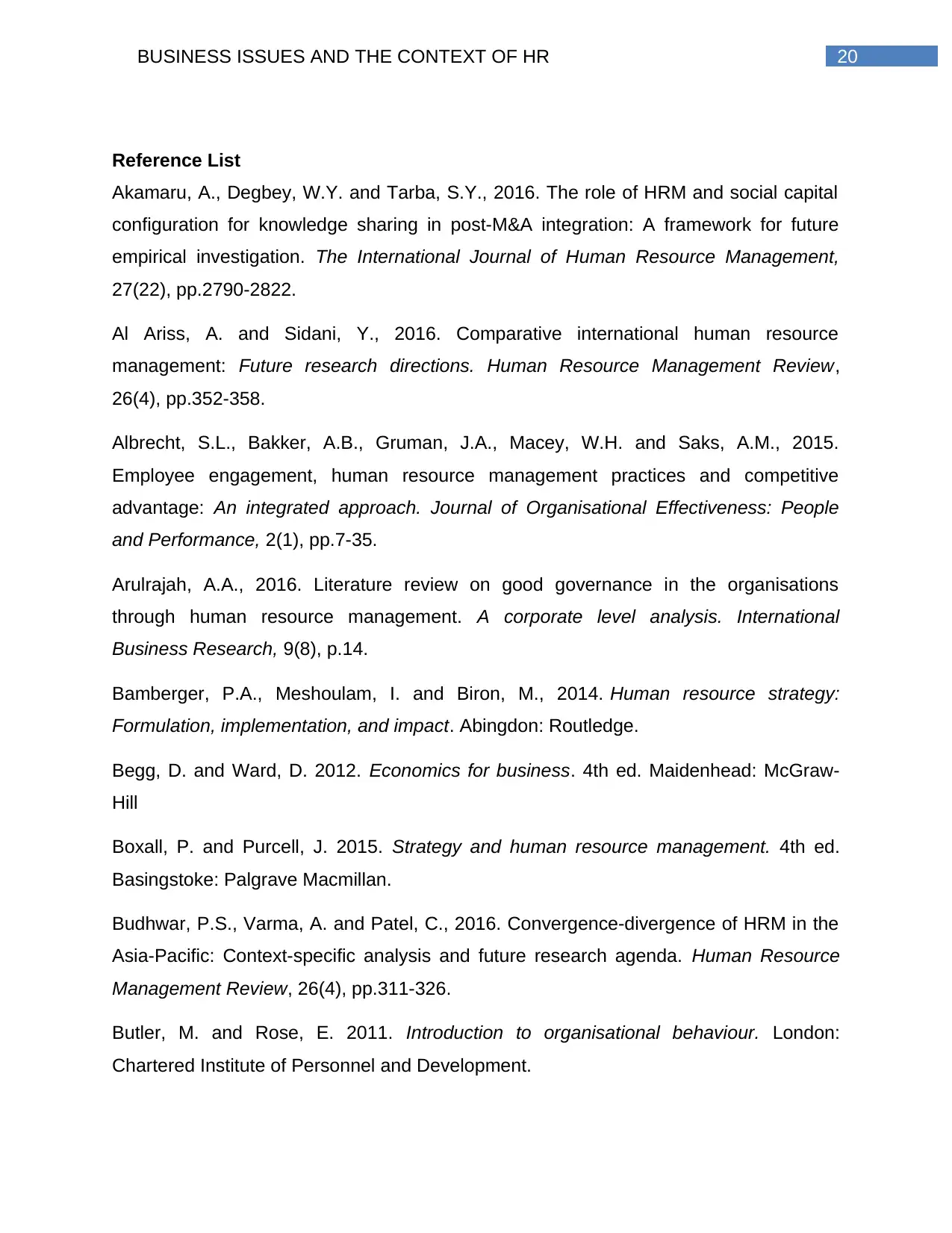
20BUSINESS ISSUES AND THE CONTEXT OF HR
Reference List
Akamaru, A., Degbey, W.Y. and Tarba, S.Y., 2016. The role of HRM and social capital
configuration for knowledge sharing in post-M&A integration: A framework for future
empirical investigation. The International Journal of Human Resource Management,
27(22), pp.2790-2822.
Al Ariss, A. and Sidani, Y., 2016. Comparative international human resource
management: Future research directions. Human Resource Management Review,
26(4), pp.352-358.
Albrecht, S.L., Bakker, A.B., Gruman, J.A., Macey, W.H. and Saks, A.M., 2015.
Employee engagement, human resource management practices and competitive
advantage: An integrated approach. Journal of Organisational Effectiveness: People
and Performance, 2(1), pp.7-35.
Arulrajah, A.A., 2016. Literature review on good governance in the organisations
through human resource management. A corporate level analysis. International
Business Research, 9(8), p.14.
Bamberger, P.A., Meshoulam, I. and Biron, M., 2014. Human resource strategy:
Formulation, implementation, and impact. Abingdon: Routledge.
Begg, D. and Ward, D. 2012. Economics for business. 4th ed. Maidenhead: McGraw-
Hill
Boxall, P. and Purcell, J. 2015. Strategy and human resource management. 4th ed.
Basingstoke: Palgrave Macmillan.
Budhwar, P.S., Varma, A. and Patel, C., 2016. Convergence-divergence of HRM in the
Asia-Pacific: Context-specific analysis and future research agenda. Human Resource
Management Review, 26(4), pp.311-326.
Butler, M. and Rose, E. 2011. Introduction to organisational behaviour. London:
Chartered Institute of Personnel and Development.
Reference List
Akamaru, A., Degbey, W.Y. and Tarba, S.Y., 2016. The role of HRM and social capital
configuration for knowledge sharing in post-M&A integration: A framework for future
empirical investigation. The International Journal of Human Resource Management,
27(22), pp.2790-2822.
Al Ariss, A. and Sidani, Y., 2016. Comparative international human resource
management: Future research directions. Human Resource Management Review,
26(4), pp.352-358.
Albrecht, S.L., Bakker, A.B., Gruman, J.A., Macey, W.H. and Saks, A.M., 2015.
Employee engagement, human resource management practices and competitive
advantage: An integrated approach. Journal of Organisational Effectiveness: People
and Performance, 2(1), pp.7-35.
Arulrajah, A.A., 2016. Literature review on good governance in the organisations
through human resource management. A corporate level analysis. International
Business Research, 9(8), p.14.
Bamberger, P.A., Meshoulam, I. and Biron, M., 2014. Human resource strategy:
Formulation, implementation, and impact. Abingdon: Routledge.
Begg, D. and Ward, D. 2012. Economics for business. 4th ed. Maidenhead: McGraw-
Hill
Boxall, P. and Purcell, J. 2015. Strategy and human resource management. 4th ed.
Basingstoke: Palgrave Macmillan.
Budhwar, P.S., Varma, A. and Patel, C., 2016. Convergence-divergence of HRM in the
Asia-Pacific: Context-specific analysis and future research agenda. Human Resource
Management Review, 26(4), pp.311-326.
Butler, M. and Rose, E. 2011. Introduction to organisational behaviour. London:
Chartered Institute of Personnel and Development.
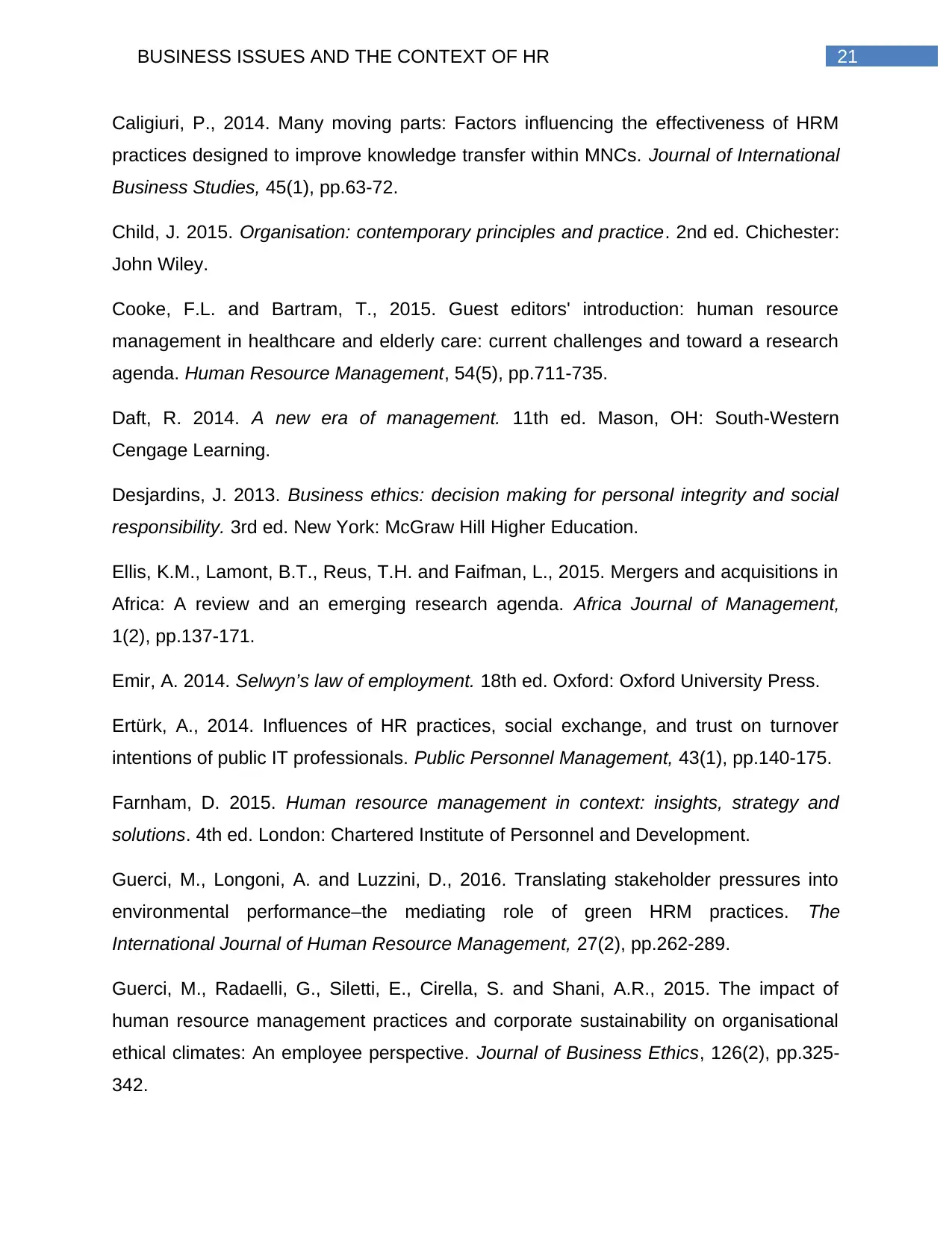
21BUSINESS ISSUES AND THE CONTEXT OF HR
Caligiuri, P., 2014. Many moving parts: Factors influencing the effectiveness of HRM
practices designed to improve knowledge transfer within MNCs. Journal of International
Business Studies, 45(1), pp.63-72.
Child, J. 2015. Organisation: contemporary principles and practice. 2nd ed. Chichester:
John Wiley.
Cooke, F.L. and Bartram, T., 2015. Guest editors' introduction: human resource
management in healthcare and elderly care: current challenges and toward a research
agenda. Human Resource Management, 54(5), pp.711-735.
Daft, R. 2014. A new era of management. 11th ed. Mason, OH: South-Western
Cengage Learning.
Desjardins, J. 2013. Business ethics: decision making for personal integrity and social
responsibility. 3rd ed. New York: McGraw Hill Higher Education.
Ellis, K.M., Lamont, B.T., Reus, T.H. and Faifman, L., 2015. Mergers and acquisitions in
Africa: A review and an emerging research agenda. Africa Journal of Management,
1(2), pp.137-171.
Emir, A. 2014. Selwyn’s law of employment. 18th ed. Oxford: Oxford University Press.
Ertürk, A., 2014. Influences of HR practices, social exchange, and trust on turnover
intentions of public IT professionals. Public Personnel Management, 43(1), pp.140-175.
Farnham, D. 2015. Human resource management in context: insights, strategy and
solutions. 4th ed. London: Chartered Institute of Personnel and Development.
Guerci, M., Longoni, A. and Luzzini, D., 2016. Translating stakeholder pressures into
environmental performance–the mediating role of green HRM practices. The
International Journal of Human Resource Management, 27(2), pp.262-289.
Guerci, M., Radaelli, G., Siletti, E., Cirella, S. and Shani, A.R., 2015. The impact of
human resource management practices and corporate sustainability on organisational
ethical climates: An employee perspective. Journal of Business Ethics, 126(2), pp.325-
342.
Caligiuri, P., 2014. Many moving parts: Factors influencing the effectiveness of HRM
practices designed to improve knowledge transfer within MNCs. Journal of International
Business Studies, 45(1), pp.63-72.
Child, J. 2015. Organisation: contemporary principles and practice. 2nd ed. Chichester:
John Wiley.
Cooke, F.L. and Bartram, T., 2015. Guest editors' introduction: human resource
management in healthcare and elderly care: current challenges and toward a research
agenda. Human Resource Management, 54(5), pp.711-735.
Daft, R. 2014. A new era of management. 11th ed. Mason, OH: South-Western
Cengage Learning.
Desjardins, J. 2013. Business ethics: decision making for personal integrity and social
responsibility. 3rd ed. New York: McGraw Hill Higher Education.
Ellis, K.M., Lamont, B.T., Reus, T.H. and Faifman, L., 2015. Mergers and acquisitions in
Africa: A review and an emerging research agenda. Africa Journal of Management,
1(2), pp.137-171.
Emir, A. 2014. Selwyn’s law of employment. 18th ed. Oxford: Oxford University Press.
Ertürk, A., 2014. Influences of HR practices, social exchange, and trust on turnover
intentions of public IT professionals. Public Personnel Management, 43(1), pp.140-175.
Farnham, D. 2015. Human resource management in context: insights, strategy and
solutions. 4th ed. London: Chartered Institute of Personnel and Development.
Guerci, M., Longoni, A. and Luzzini, D., 2016. Translating stakeholder pressures into
environmental performance–the mediating role of green HRM practices. The
International Journal of Human Resource Management, 27(2), pp.262-289.
Guerci, M., Radaelli, G., Siletti, E., Cirella, S. and Shani, A.R., 2015. The impact of
human resource management practices and corporate sustainability on organisational
ethical climates: An employee perspective. Journal of Business Ethics, 126(2), pp.325-
342.
Secure Best Marks with AI Grader
Need help grading? Try our AI Grader for instant feedback on your assignments.
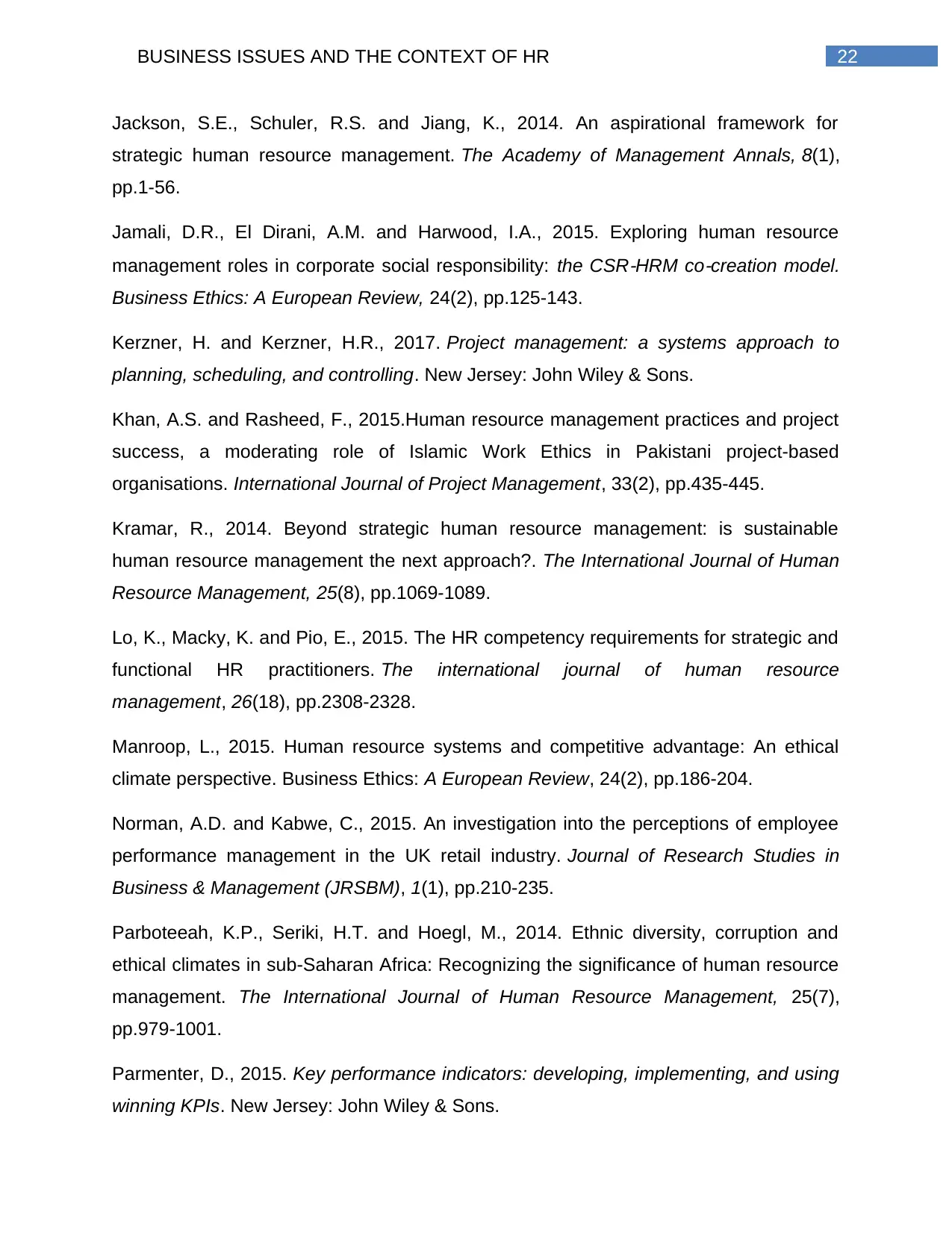
22BUSINESS ISSUES AND THE CONTEXT OF HR
Jackson, S.E., Schuler, R.S. and Jiang, K., 2014. An aspirational framework for
strategic human resource management. The Academy of Management Annals, 8(1),
pp.1-56.
Jamali, D.R., El Dirani, A.M. and Harwood, I.A., 2015. Exploring human resource
management roles in corporate social responsibility: the CSR
‐HRM co
‐creation model.
Business Ethics: A European Review, 24(2), pp.125-143.
Kerzner, H. and Kerzner, H.R., 2017. Project management: a systems approach to
planning, scheduling, and controlling. New Jersey: John Wiley & Sons.
Khan, A.S. and Rasheed, F., 2015.Human resource management practices and project
success, a moderating role of Islamic Work Ethics in Pakistani project-based
organisations. International Journal of Project Management, 33(2), pp.435-445.
Kramar, R., 2014. Beyond strategic human resource management: is sustainable
human resource management the next approach?. The International Journal of Human
Resource Management, 25(8), pp.1069-1089.
Lo, K., Macky, K. and Pio, E., 2015. The HR competency requirements for strategic and
functional HR practitioners. The international journal of human resource
management, 26(18), pp.2308-2328.
Manroop, L., 2015. Human resource systems and competitive advantage: An ethical
climate perspective. Business Ethics: A European Review, 24(2), pp.186-204.
Norman, A.D. and Kabwe, C., 2015. An investigation into the perceptions of employee
performance management in the UK retail industry. Journal of Research Studies in
Business & Management (JRSBM), 1(1), pp.210-235.
Parboteeah, K.P., Seriki, H.T. and Hoegl, M., 2014. Ethnic diversity, corruption and
ethical climates in sub-Saharan Africa: Recognizing the significance of human resource
management. The International Journal of Human Resource Management, 25(7),
pp.979-1001.
Parmenter, D., 2015. Key performance indicators: developing, implementing, and using
winning KPIs. New Jersey: John Wiley & Sons.
Jackson, S.E., Schuler, R.S. and Jiang, K., 2014. An aspirational framework for
strategic human resource management. The Academy of Management Annals, 8(1),
pp.1-56.
Jamali, D.R., El Dirani, A.M. and Harwood, I.A., 2015. Exploring human resource
management roles in corporate social responsibility: the CSR
‐HRM co
‐creation model.
Business Ethics: A European Review, 24(2), pp.125-143.
Kerzner, H. and Kerzner, H.R., 2017. Project management: a systems approach to
planning, scheduling, and controlling. New Jersey: John Wiley & Sons.
Khan, A.S. and Rasheed, F., 2015.Human resource management practices and project
success, a moderating role of Islamic Work Ethics in Pakistani project-based
organisations. International Journal of Project Management, 33(2), pp.435-445.
Kramar, R., 2014. Beyond strategic human resource management: is sustainable
human resource management the next approach?. The International Journal of Human
Resource Management, 25(8), pp.1069-1089.
Lo, K., Macky, K. and Pio, E., 2015. The HR competency requirements for strategic and
functional HR practitioners. The international journal of human resource
management, 26(18), pp.2308-2328.
Manroop, L., 2015. Human resource systems and competitive advantage: An ethical
climate perspective. Business Ethics: A European Review, 24(2), pp.186-204.
Norman, A.D. and Kabwe, C., 2015. An investigation into the perceptions of employee
performance management in the UK retail industry. Journal of Research Studies in
Business & Management (JRSBM), 1(1), pp.210-235.
Parboteeah, K.P., Seriki, H.T. and Hoegl, M., 2014. Ethnic diversity, corruption and
ethical climates in sub-Saharan Africa: Recognizing the significance of human resource
management. The International Journal of Human Resource Management, 25(7),
pp.979-1001.
Parmenter, D., 2015. Key performance indicators: developing, implementing, and using
winning KPIs. New Jersey: John Wiley & Sons.
1 out of 23
Related Documents
Your All-in-One AI-Powered Toolkit for Academic Success.
+13062052269
info@desklib.com
Available 24*7 on WhatsApp / Email
![[object Object]](/_next/static/media/star-bottom.7253800d.svg)
Unlock your academic potential
© 2024 | Zucol Services PVT LTD | All rights reserved.





